The forecast was for an occluded front to sweep through from the north early afternoon, with low cloud and rain. So it was with trepidation that I drew back the curtains in the bedroom, getting up for my 10:00 aerobatics lesson on Saturday. Sure enough, it was virtually overcast, but to me, the clouds looked quite high – hmmm maybe.
Anyway, Max had said if the weather was pants we would do the ‘formal sign-off checks’ for the Robin – you know, PFL’s, different landings and take-off etc. Max is nothing if not extremely thorough. So off I went to the airfield.
Max decides we should ‘have a look’ and do the check-ride with a few aeros thrown in. This could be a long lesson as Max was had a free slot after me anyway.
Off we went with Max asking me to do a short field take-off with best angle of climb so we would be at least 250’ by the end of runway 22. Applied full power, hold her on the toe brakes and allow the rpm to build, then let her go with a little back pressure so she would ‘unstick’ and get into ground effect ASAP. So far so good, speed to 65kts and steep angle of climb to maintain 65kts. Although not a fantastic climber, she was probably closer to 500’; by the end of the runway, partly a reflection of the 12 kts headwind.
Up we went and headed for higher cloud and better looking weather to the north-west (also me thinking – hmmm…. Berrow and Ledbury grass strips out that way, great for a ‘trick’ PFL – hmmmm….). Sure enough, around Berrow at 3000’, the engine cuts out on me (i.e. Max pulls the power and declares an ‘engine failure’). So into my own (not easily memorised!) mnemonic: GWPERS: Glide – Wind – Pick – Engine – Radio – Shutdown.
Best glide at 70kts, turn away from wind so you are ‘downwind’ (this gives me more groundspeed so more choices). Pick – oh look – a nicely mown grass strip off to the right, that’ll do! Above 2000’, try to restart the engine, Max calls no restart (what a surprise). Talk through the mayday call without keying the mike and set transponder to 7700. Turn base at 1200’. Coming onto final, looks high to me, so I pulled on two stages of flap. Shutdown checks. Height coming off. Maintain best glide. Damn that headwind, I think I am losing too much height. As we descend to within probably 200’, I think we probably will make the end of the strip – just. Max calls for a go-around and off we go.
That was the first PFL I have done for a good couple of years, and apart from being a bit touch-and-go on the height, I think we would have made it, so score one for the good guys!
The some steep turns. First 45 degrees then greater than 60 degrees. The 60 degrees was fun, but I held height and eventually found the ‘balance’. Max then showed me a ‘competition’ steep turn. The difference being that you don’t seem to bother with a balanced turn, just flick it into the turn as quickly as possible with an equally sudden roll out. Although with the pedestrian roll rate of the Robin, it was hardly an eyeball-popping experience!
Then around the Ledbury mast (hmmm….Ledbury grass strip nearby) and yes, another engine failure. Same again, but this time, I was much happier with the height and perhaps if the weather was better (strip could have been a bit boggy), Max would have asked me to actually land. We did a go-around then back upstairs for some aerobatics.
The rolls were better this time, with me getting more right than wrong. It is the angle of pull-up and checking forward properly (without residual back pressure) that count here with me.
The loops went pretty good I thought, apart from the first one which was a bit scruffy – pulled up too hard and still to one side a bit, so angled over in the inverted and a bit too much float.
Stall turns? Well, in my time honoured manner, the first one went pear shaped. I left it a bit late and wasn’t fast enough on the rudder reversal. We started to go around, then it sloooowwwed – will it make it… maybe… maybe… Yes? WHAP! NO! I think she flicked forward and went past the vertical as I recovered. If anything, I am getting good practice on recoveries! ‘Yeah – that was a hammerhead’ Max declares laconically. So I guess any time I want to do a hammerhead, all I have to do is screw up a stall turn – how tough can it be???
Next one I switch rudder a bit early and despite opposite aileron, there is adverse roll. We get around and do a stall turn, but even I knew it was ‘scruffy’. I do manage the next two though – not as well as Max and his demo’s, but I think I am starting to get the hang of the timing and the suddenness of the rudder reversal.
Back to the airfield for a variety of landings. The short field is flattering, but part of the credit must go to the 12-15 kts headwind! Though I say it myself, the glide landing went really well. Kept plenty of height, then when I was certain of getting in, brought it back to a nice soft touch past the numbers. My crosswinds aren’t too great, I find the stick control quite different from the yoke and Max seems to want quite a lot of aileron and rudder, far more than I would have thought the conditions warranted, but he is the boss! More practice required here methinks.
We land and debrief. Max sign’s me off for non-aerobatic flights in the mighty Robin. He hums-and-haws as to whether to send me up next time for solo aerobatics and then decides (and I am happy to agree) to do maybe one more dual session and see how I get on, then have me practice the moves solo for a bit, before coming back to him for any fine tuning that is bound to be necessary, then he would show me some new manoeuvres and we would practice those. Sounds OK to me.
Quite a good session and I clock up 1.8 hours – and yes, I do feel a bit tired after this one!
Afterwards, I meet up with Manuel and we have a very slow and careful walk-through of the pre-flight checks and start-up drills for the RV6 which I have just bought a share in. I have now booked my first lesson with a Cotswolds instructor who also part-owns an RV4 – so is a very experienced tailwheel instructor. Looks like I will be learning both tailwheel on the RV6 and aerobatics on the Robin at the same time – hope the finances and my brain can stand the strain!
Monday, November 26, 2007
Monday, November 19, 2007
Today was a good day!
All week, the weather was superb. From my office window, I looked out on clear, cold, crisp high pressure weather with clear skies and minimal wind. Of course the forecast for the weekend was for this to break, but not until Sunday – at least that was the forecast. I got up early for my 10:00 Saturday aerobatics lesson and looked out of the east facing window – not good, solid overcast hard to say what altitude, but looked about 3000’. Out of the west facing window, similar, but off to the far west was near open, blue skies. With luck, this would work its way over by the time I breakfasted and made it to the airfield. And so it transpired.
I checked out G-EWHT and it had obligingly been left with just under half-fuel (any more and we would be too heavy for aerobatics).
Max turned up and his pre-flight briefing was succinct and to the point ‘Same again - alright?’ he said in his distinctive Gloster brogue. I knew what he meant and had gone through all the moves and ‘what if’s’ in my head already, so that was all the briefing I needed.
We started up and moved off. Another foible of the Robin I discovered when doing the ‘after start’ checks is not to bother with mag drops and a really cold engine would die – leave them to the power checks when the engine is warmer.
Power checks were fine and off we went to the preferred playground to the south-west of the airfield, to the western banks of the River Severn by the very distinctive ‘bends in the river’ (….random thought….I MUST get down there one day to see the Severn Bore!). The Robin gamely clawed its way upwards to gain altitude at the usual 500fpm or less until (eventually) we got to 4000’ QNH.
HASELL checks complete and transponder set to 7004, we started off the usual ‘mixed bag’ of rolls, loops, stall turns and recoveries, working the area.
Rolls
I had issues with these last time and I wasn’t sure why. First one was similar and Max decided I wasn’t pulling up enough. So pulled up a further 10 degrees and this was better. Then on the last two rolls, instead of the usual (and frankly easy) ballistic rolls, I tried the ‘push forward while inverted’ thing to ‘flatten out’ the bottom of the sacred circle. First one went well, but I got the timing wrong on the second one. However, all in all, a good ‘roll’ session.
Loops
I thought a lot better this time. I am trying hard to make fluid and progressive movements with the stick, rather than my more ‘mechanical’ approach of earlier sessions. The float was better, but I need better power and pull out control as I am not pulling enough power off past the float (when the engine sounds like it is dying), so the engine picks up speed very quickly in the pull out and I have to pull back quickly so it doesn’t overspeed.
Stall Turns
First one went pear shaped as usual! Pulled up and started applying right rudder, but left wing was too high, so I held off on the rudder a bit, then when I started applying again, I had lost all energy and a sharp reversal to left rudder was punished by the world suddenly flopping around me with green ground and muddy brown river filling the forward view. I went into recovery mode, pulled the power off, pulled out and back to straight and level. Lousy stall turn, but good recovery!
Actually, all in all, good progress this time. After a couple that cocked-up, Max figured what I was doing wrong, which is that I was pulling up, but with a bit of a pull to the right at the same time. So I was seeing the left wing high because I had aileron input in. Knowing this, I can now set about fixing it and concentrating on getting more assertive on the timing of the rudder reversal, which I suspect will only come with practice. I am reluctant to ‘cheat’ and work it on counting the time from when I get to the vertical until the rudder reversal as this would then be specific to the aircraft, the weight of the two passengers and the fuel load – so if I tried the same when solo with low fuel, I could be way out.
On the way back, Max got me to string to moves one after the other to demonstrate the importance of getting back to ‘the 110kts attitude’. This I did. Particularly enjoyed the stall turn followed by the loop – yeehaaa!
Back to Gloucester for a direct join to right base for 22. Another reasonable landing I thought.
Max thinks I am not far from being sent off for some solo aerobatics. No, not a sign-off, just the next step I assume before further P U/T consolidation and moving onto to other manoeuvres. I have to say I look forward to this hugely. What with one thing and another, I haven’t flown an aircraft P1 since September and don’t look like doing so anytime soon (what with tailwheel difference training coming up on the RV6 and an overdue FAA BFR) – I think I have forgotten what it is like to have no one in the right seat!
Still, it’s exciting (if expensive) flying and I am having a ball!
I checked out G-EWHT and it had obligingly been left with just under half-fuel (any more and we would be too heavy for aerobatics).
Max turned up and his pre-flight briefing was succinct and to the point ‘Same again - alright?’ he said in his distinctive Gloster brogue. I knew what he meant and had gone through all the moves and ‘what if’s’ in my head already, so that was all the briefing I needed.
We started up and moved off. Another foible of the Robin I discovered when doing the ‘after start’ checks is not to bother with mag drops and a really cold engine would die – leave them to the power checks when the engine is warmer.
Power checks were fine and off we went to the preferred playground to the south-west of the airfield, to the western banks of the River Severn by the very distinctive ‘bends in the river’ (….random thought….I MUST get down there one day to see the Severn Bore!). The Robin gamely clawed its way upwards to gain altitude at the usual 500fpm or less until (eventually) we got to 4000’ QNH.
HASELL checks complete and transponder set to 7004, we started off the usual ‘mixed bag’ of rolls, loops, stall turns and recoveries, working the area.
Rolls
I had issues with these last time and I wasn’t sure why. First one was similar and Max decided I wasn’t pulling up enough. So pulled up a further 10 degrees and this was better. Then on the last two rolls, instead of the usual (and frankly easy) ballistic rolls, I tried the ‘push forward while inverted’ thing to ‘flatten out’ the bottom of the sacred circle. First one went well, but I got the timing wrong on the second one. However, all in all, a good ‘roll’ session.
Loops
I thought a lot better this time. I am trying hard to make fluid and progressive movements with the stick, rather than my more ‘mechanical’ approach of earlier sessions. The float was better, but I need better power and pull out control as I am not pulling enough power off past the float (when the engine sounds like it is dying), so the engine picks up speed very quickly in the pull out and I have to pull back quickly so it doesn’t overspeed.
Stall Turns
First one went pear shaped as usual! Pulled up and started applying right rudder, but left wing was too high, so I held off on the rudder a bit, then when I started applying again, I had lost all energy and a sharp reversal to left rudder was punished by the world suddenly flopping around me with green ground and muddy brown river filling the forward view. I went into recovery mode, pulled the power off, pulled out and back to straight and level. Lousy stall turn, but good recovery!
Actually, all in all, good progress this time. After a couple that cocked-up, Max figured what I was doing wrong, which is that I was pulling up, but with a bit of a pull to the right at the same time. So I was seeing the left wing high because I had aileron input in. Knowing this, I can now set about fixing it and concentrating on getting more assertive on the timing of the rudder reversal, which I suspect will only come with practice. I am reluctant to ‘cheat’ and work it on counting the time from when I get to the vertical until the rudder reversal as this would then be specific to the aircraft, the weight of the two passengers and the fuel load – so if I tried the same when solo with low fuel, I could be way out.
On the way back, Max got me to string to moves one after the other to demonstrate the importance of getting back to ‘the 110kts attitude’. This I did. Particularly enjoyed the stall turn followed by the loop – yeehaaa!
Back to Gloucester for a direct join to right base for 22. Another reasonable landing I thought.
Max thinks I am not far from being sent off for some solo aerobatics. No, not a sign-off, just the next step I assume before further P U/T consolidation and moving onto to other manoeuvres. I have to say I look forward to this hugely. What with one thing and another, I haven’t flown an aircraft P1 since September and don’t look like doing so anytime soon (what with tailwheel difference training coming up on the RV6 and an overdue FAA BFR) – I think I have forgotten what it is like to have no one in the right seat!
Still, it’s exciting (if expensive) flying and I am having a ball!
Tuesday, November 13, 2007
Late afternoon aerobatics
Some you win and some you lose! This particular lesson I lost – that is to say I didn’t have a great lesson! Having said that, you learn more from your mistakes, so on that basis, I learned a lot! But to be fair to myself (we can all be our own worst critics), it wasn’t all bad.
The weather was fine, if breezy around midday, but my lesson was for 15:00. By then, the very scattered and high cloud had been replaced by broken at 2300’ with tops at about 4000’ and still breezy, but with some holes.
Had a briefing about vertical recovery, so that was clearly the plan. Max commented that it was far more genuine if I cocked things up, then used the recovery techniques to sort myself out (thinks…. I’m sure I can oblige!).
Off we went and headed to the SW. We climbed past the low stuff into a hole around ‘bends in the river’ and headed up to 5000’. The Robin clawed its way skyward at about 3-400 fpm. I levelled off in what was a smallish hole – probably too small - but a bigger one beckoned to the east, so we headed over around Badminton, but clear of Lyneham into a much bigger hole.
Max wanted me to start with a stall-turn – hmmm…. So I think it through first (and the recovery technique), then down we go to ‘standard entry’ to get the 110 kts speed and attitude. Stabilise at 110 kts attitude, check wings level and……PULL….FULL POWER…..PULL to vertical, check forward to hold vertical, start to feed in right rudder…oh hell, I feel I am past vertical (probably didn’t check forward enough) and the port wing is way too high, so we are canted over…..oh heck here it comes……. WHACK – flick stall into a hammerhead. Get on with the recovery – stick back and steady, centralise, throttle closed at the same time, ground filling the windscreen so we are vertically down and pull back to recover. Well, the bad news is that I cocked the stall-turn up big time (in both pitch and yaw – tres bon!), but I knew what was coming and managed the recovery feeling pretty calm.
After a debrief (too slow at feeding in right rudder, too hesitant at whacking to left rudder, didn’t check the pull and pulled past vertical – apart from that fine :-). I try again. This time, much better and although Max gave me the word to switch rudder, I was about to do so, so my timing is coming on. Only mistake was that I centralised rudder and aileron just before the ‘knife’ position (the nose going back through the horizon), when I should be doing it at or just after.
Then onto just one loop IIRC. It went pretty well, certainly managed to get around and I am sure we went through our own wake as I felt that distinctive ‘speed bump’. However, Max commented (quite correctly) that I was a ‘mechanical’ on the stick easing back into the float and didn’t allow it to float long enough – it should be a smooth movement on the stick in pitch. Now that I can get it around and carry out all control and throttle movements by myself, Max is obviously now trying to ‘clean up’ points he hasn’t pulled me up on until now for fear of overloading me, so that must be progress right?
I climbed back up to 4500’ or at least tried to! I had full power on, a definitely climb attitude, then engine rpm was normal (no MP readout), but we were either not climbing at all or had a ‘negative-climb’ (i.e. descent!) going on! I pointed this out to Max and it seemed we were in a down-wave of airmass. Turned 30 degree and started a very modest 200 fpm climb.
We did a fair few rolls to the left and right. But despite my best efforts and definitely getting the plane to 30 degrees pitch, we kept coming out more nose down than we should. Max thought it was me pulling back a bit once I put the ailerons across. I wasn’t aware of doing this, but they weren’t a crisp as previous lessons. Max tried one and I have to say, he was pretty nose down on exit as well, but maybe not as much as me. I’ll take on board that I must have been sub-consciously pulling a bit, but I have to say, I think there were other factors at play today – heavier on the fuel load, down-draft, higher than usual etc. It sounds like excuses, but I don’t think it is – we’ll see next time.
The wind was picking up and as we headed in the Gloucester direction, the DME showed a groundspeed of 25 kts! We had a chat about those absurd situations where a pilot can be in such a strong headwind in such a modestly performing aircraft, that they can pull the power back a bit and have a zero groundspeed and ‘hover’ over the same patch of ground, or indeed be positively blown backwards!
Anyway, rather than get ‘caught out’ playing in this hole and getting blown further and further south east, we went VMC on-top at 5000’ heading back towards the airfield looking for another hole.
By now, the sun was starting to get very low and picked up some lovely reds and oranges in the clouds. We were VMC on-top and I was struck with how peaceful and picturesque it all was and how lucky I was to be there at precisely this moment – it really was one of those ‘wooOOOOwwwww’ moments! No camera of course – what a pity.
We chased what looked to be holes at the edge of the next ridge of clouds for several ridges – a bit like the numerous false crests you see while hill walking in the lake district! It dawned on us that with the light fading and with no holes materialising, this was the end of the lesson and we turned a hunt for holes nearer the airfield into a route back to the circuit.
One slight issue though - we were VMC on-top with no holes, so we had to either find a hole or do a let down through the clouds of some sort. The ATIS gave the cloudbase as 3000’ and with an MSA in the area of 2800’ Max asked if I was happy to do a let down on the current heading of due north (i.e. not shoot the NDB/DME approach for Gloucester). I was happy enough as I do have a current IMC rating, although I haven’t used it in anger for several months and even then, never with a ‘stick’ aircraft, so it should be fun. I checked the AI which was now stable and functioning correctly (after having toppled several times during aerobatics). Synchronised the DI with the compass, pitot heat on and down we went and into the clag.
I kept my eyes firmly on the AI with the usual ‘T-shaped’ instrument scan, but of course studiously avoiding the temptation to try to get visual clues from outside the canopy. OK – forgot to turn off the strobes which were going off like flashbulbs in the cloud, but it didn’t distract too much, although Max kindly flicked them off anyway. I held the heading and kept a sensible rate of descent. At about 3400’ I could ‘sense’ darker patches (i.e. breaks through the cloud to the now dark clear sky below the cloudbase) with peripheral vision. I managed to avoid the temptation to switch prematurely to visual and we finally broke out ‘properly’ at around 2800’.
It was getting pretty dark now as we radioed for a direct join if possible. Given left base join for 27. Headed for the ‘doughnut’ building and turned final. The runway lights are on and if it isn’t official night, then it is doing a pretty good impersonation of it!
Good approach and I thought a pretty fair landing – it may not have been ‘official night’ but it was for all intents and purposes. Taxy back and shut down.
All in all, a bit of a disappointment – but strangely, I feel OK about it. I know what I did wrong (except for the rolls that is!), I know what to do to get it right and I know what to do when it goes pear-shaped and get on and do it.
Booked another lesson for next weekend of course! Wouldn’t it be nice to have one of those clear, crisp high-pressure, ‘good-to-be-alive’ days next Saturday!!
The weather was fine, if breezy around midday, but my lesson was for 15:00. By then, the very scattered and high cloud had been replaced by broken at 2300’ with tops at about 4000’ and still breezy, but with some holes.
Had a briefing about vertical recovery, so that was clearly the plan. Max commented that it was far more genuine if I cocked things up, then used the recovery techniques to sort myself out (thinks…. I’m sure I can oblige!).
Off we went and headed to the SW. We climbed past the low stuff into a hole around ‘bends in the river’ and headed up to 5000’. The Robin clawed its way skyward at about 3-400 fpm. I levelled off in what was a smallish hole – probably too small - but a bigger one beckoned to the east, so we headed over around Badminton, but clear of Lyneham into a much bigger hole.
Max wanted me to start with a stall-turn – hmmm…. So I think it through first (and the recovery technique), then down we go to ‘standard entry’ to get the 110 kts speed and attitude. Stabilise at 110 kts attitude, check wings level and……PULL….FULL POWER…..PULL to vertical, check forward to hold vertical, start to feed in right rudder…oh hell, I feel I am past vertical (probably didn’t check forward enough) and the port wing is way too high, so we are canted over…..oh heck here it comes……. WHACK – flick stall into a hammerhead. Get on with the recovery – stick back and steady, centralise, throttle closed at the same time, ground filling the windscreen so we are vertically down and pull back to recover. Well, the bad news is that I cocked the stall-turn up big time (in both pitch and yaw – tres bon!), but I knew what was coming and managed the recovery feeling pretty calm.
After a debrief (too slow at feeding in right rudder, too hesitant at whacking to left rudder, didn’t check the pull and pulled past vertical – apart from that fine :-). I try again. This time, much better and although Max gave me the word to switch rudder, I was about to do so, so my timing is coming on. Only mistake was that I centralised rudder and aileron just before the ‘knife’ position (the nose going back through the horizon), when I should be doing it at or just after.
Then onto just one loop IIRC. It went pretty well, certainly managed to get around and I am sure we went through our own wake as I felt that distinctive ‘speed bump’. However, Max commented (quite correctly) that I was a ‘mechanical’ on the stick easing back into the float and didn’t allow it to float long enough – it should be a smooth movement on the stick in pitch. Now that I can get it around and carry out all control and throttle movements by myself, Max is obviously now trying to ‘clean up’ points he hasn’t pulled me up on until now for fear of overloading me, so that must be progress right?
I climbed back up to 4500’ or at least tried to! I had full power on, a definitely climb attitude, then engine rpm was normal (no MP readout), but we were either not climbing at all or had a ‘negative-climb’ (i.e. descent!) going on! I pointed this out to Max and it seemed we were in a down-wave of airmass. Turned 30 degree and started a very modest 200 fpm climb.
We did a fair few rolls to the left and right. But despite my best efforts and definitely getting the plane to 30 degrees pitch, we kept coming out more nose down than we should. Max thought it was me pulling back a bit once I put the ailerons across. I wasn’t aware of doing this, but they weren’t a crisp as previous lessons. Max tried one and I have to say, he was pretty nose down on exit as well, but maybe not as much as me. I’ll take on board that I must have been sub-consciously pulling a bit, but I have to say, I think there were other factors at play today – heavier on the fuel load, down-draft, higher than usual etc. It sounds like excuses, but I don’t think it is – we’ll see next time.
The wind was picking up and as we headed in the Gloucester direction, the DME showed a groundspeed of 25 kts! We had a chat about those absurd situations where a pilot can be in such a strong headwind in such a modestly performing aircraft, that they can pull the power back a bit and have a zero groundspeed and ‘hover’ over the same patch of ground, or indeed be positively blown backwards!
Anyway, rather than get ‘caught out’ playing in this hole and getting blown further and further south east, we went VMC on-top at 5000’ heading back towards the airfield looking for another hole.
By now, the sun was starting to get very low and picked up some lovely reds and oranges in the clouds. We were VMC on-top and I was struck with how peaceful and picturesque it all was and how lucky I was to be there at precisely this moment – it really was one of those ‘wooOOOOwwwww’ moments! No camera of course – what a pity.
We chased what looked to be holes at the edge of the next ridge of clouds for several ridges – a bit like the numerous false crests you see while hill walking in the lake district! It dawned on us that with the light fading and with no holes materialising, this was the end of the lesson and we turned a hunt for holes nearer the airfield into a route back to the circuit.
One slight issue though - we were VMC on-top with no holes, so we had to either find a hole or do a let down through the clouds of some sort. The ATIS gave the cloudbase as 3000’ and with an MSA in the area of 2800’ Max asked if I was happy to do a let down on the current heading of due north (i.e. not shoot the NDB/DME approach for Gloucester). I was happy enough as I do have a current IMC rating, although I haven’t used it in anger for several months and even then, never with a ‘stick’ aircraft, so it should be fun. I checked the AI which was now stable and functioning correctly (after having toppled several times during aerobatics). Synchronised the DI with the compass, pitot heat on and down we went and into the clag.
I kept my eyes firmly on the AI with the usual ‘T-shaped’ instrument scan, but of course studiously avoiding the temptation to try to get visual clues from outside the canopy. OK – forgot to turn off the strobes which were going off like flashbulbs in the cloud, but it didn’t distract too much, although Max kindly flicked them off anyway. I held the heading and kept a sensible rate of descent. At about 3400’ I could ‘sense’ darker patches (i.e. breaks through the cloud to the now dark clear sky below the cloudbase) with peripheral vision. I managed to avoid the temptation to switch prematurely to visual and we finally broke out ‘properly’ at around 2800’.
It was getting pretty dark now as we radioed for a direct join if possible. Given left base join for 27. Headed for the ‘doughnut’ building and turned final. The runway lights are on and if it isn’t official night, then it is doing a pretty good impersonation of it!
Good approach and I thought a pretty fair landing – it may not have been ‘official night’ but it was for all intents and purposes. Taxy back and shut down.
All in all, a bit of a disappointment – but strangely, I feel OK about it. I know what I did wrong (except for the rolls that is!), I know what to do to get it right and I know what to do when it goes pear-shaped and get on and do it.
Booked another lesson for next weekend of course! Wouldn’t it be nice to have one of those clear, crisp high-pressure, ‘good-to-be-alive’ days next Saturday!!
Monday, November 12, 2007
New share?
Having left the ‘start-up share’ in the Beech Bonanza (for a variety of reasons), I have been looking for alternatives.
Being without a share gives you the chance to assess where you are with your flying and what you might want to do. As a result, a few weeks ago, I started aerobatics training with a club aircraft.
As regards the share, well, I have done some touring and certainly done the ‘spamcan thing’. I think my flying and priorities now are:
• Try to reduce the cost (both monthlies and hourlies),
• Group of an absolute maximum of six (still not ready to go the whole hog and buy my own)
• I will still do touring mainly
• Ideally, the aircraft would also be aerobatic (e.g. Bulldog etc.)
• An ‘interesting’ aircraft or certainly something interesting about it (e.g. if it is a Cessna spamcan, maybe based at a farmstrip etc.)
• Ideally four seat, but wouldn’t rule out two seat.
• Would consider a PFA permit (should be cheaper to run) but would be sorry to lose use of IMC rating)
That’s a pretty long list, but really uppermost would be the need to reduce the cost and to fly something ‘interesting’.
Having had a look at a few locations, and options I kept coming back to Gloucester as being the ideal airfield. I did see a share in a very nice DR400 based at Bidford, but when I went to Bidford, there was no flying due to water-logging of the grass strip (kind of limiting) and they wanted a ‘mere’ £27,000 for the share – so a quick no on that!
I had heard that Manuel Quieroz was selling shares in his tidy RV6 based at Gloucester (he flew solo around the world in this plane in the ‘chasing the morning sun’ expedition). It is a group of six with five shares now sold. The monthlies and hourlies are reasonable and it certainly meets the ‘interesting aircraft’ requirement, although disappoints for aerobatics and IMC etc. (but I had long ago reconciled myself to not being able to have everything in one package unless I bought outright).
I have spoken to Manuel a few times and of course heard his talk on his epic flight at the Flyer Summer Bash this year. He is well known, well liked and respected and we seem to get on fine.
I talked to him about the share. The weight and balance is interesting, with a MAUW of 907kg for single occupancy (i.e. pilot only) but only 726kg for a pilot plus a passenger – apparently as legacy of his round the world trip, where he was surrounded by fuel tanks everywhere (and probably only had two pairs of underpants and a toothbrush for baggage!). The ‘dual occupancy’ MAUW was disappointing, but could be made to work for myself and the wife, or someone significantly lighter than my 210lbs MAUW!
An interesting aircraft in that it is very high performance (150kts) and a taildragger.

I have heard great things about RV’s and the near fanatical following and loyalty they engender. Claims of ‘fighter-like’ handling and ‘a joy to fly’ did more than pique my curiosity. Could these claims be true? If so, would that be enough to overcome the missing ticks in the requirements list?
The only thing for it was a trial flight. We tried for this last weekend but were defeated by a fog which never lifted around the airfield (although apparently it was glorious a mere five miles away). We were reduced to sitting in the aircraft in the hangar with the canopy down, making aircraft noises! The serious point was of course to see whether I ‘fitted’ with my 6’ 2” frame and headsets on. The answer was ‘probably, maybe, just’. The padded band on top of my DC13.4’s was touching the canopy if I moved my head too far towards the outside. But I was still concerned to see how it would feel in flight with maybe some buffet. So we agreed to call each other the next Saturday and take a call on the weather.
This we duly did and the weather seemed quite flyable, with a low overcast at 2000’ starting to break up nicely, but something of a wind, albeit straight down runway 27.
Manuel carefully went through the walk-round checklist (undoubtedly for my benefit as I am sure he can do it blindfolded by now). We pulled her out, climbed on board and started up. The view forward while taxying is very limited as you would expect in a taildragger, but actually not as bad as I had thought.
The digital engine monitoring system would take a bit of getting used to as we did the power checks.
Cleared for take off as Manuel applied full power. At about 45kts, he nudges forward on the stick to get the tail up, then holds her down until flying speed and eases her off. All of this happens very quickly and we are flying after very little runway (partly due to a light fuel load and partly a 15kt headwind). Nonetheless, we are definitely climbing at a sprightly 1000’ - 1300’ fpm.
We head out west and level off. The speed builds to 150 kts indicated as Manuel brings the power back to about 75% cruise. It is a bit bumpy up here, so it is a good test for headroom clearance. I can honestly say that at no time in the flight was I aware of the restricted headroom or of my headband touching the canopy.
Manuel demonstrates the sensitivity and feel of the controls by raking the RV over into a very steep turn either way. The roll rate is very brisk indeed – closer to the Extra 300 than the more sedate Robin! He demonstrates that it is very sensitive in pitch, with some positive G pull-ups and ‘bum off the seat’ push-over bunts.
He invites me to try the controls. He is right of course. The stick is best flown with thumb and forefinger and what I can best describe as ‘pressure’ in the direction you want to go. I needs little more than rudder pressure for a balanced turn and most passengers wouldn’t notice if you turned without rudder. I really do see what they mean by ‘fighter-like’ response and ‘a joy to fly’ – this is great fun.
However, for those long ‘touring legs’ he also has a ‘heading and height’ auto-pilot that can be slaved to the GPS.
Manuel takes over again as we near Bredon Hill. He spots an aircraft slightly below on an opposite heading and decides to turn around to catch him back up to demonstrate the turn of speed. We stay above and well to the right as we catch up to what turns out to be an RV8. A quick wing-rock in acknowledgement as we head away and back to Gloucester.
On the way back, Manuel shows me the slow flight and stall characteristics. It wouldn’t be easy to stall without realising it as we are virtually hanging from the prop before it stall with a very benign nose down and almost immediately she is flying again. There is a bit of wing-drop to the left with full flaps, but nothing scary. Flying at 100kts in slow flight feels like we are standing still.
Back to the airfield and we get a standard overhead join for 27. Back to 100 kts for the circuit. Conventional ‘three-point’ attitude for landing and control with the throttle. We touch and bounce, Manuel controls the bounce and we touch and hop again before finally settling. She really wanted to carry on flying.
Well what to do? It is a really interesting aircraft and will need me to get my taildragger rating (I already have 7 hours taildragging on the Cub and was close to sign-off before the clock change put paid to evening lessons after work). Manuel is happy for me to train in the RV6 – in fact it is so massively different from the cub, I would need difference training anyway! It is fast and would be a fine tourer for two people with careful luggage management.
I left it with Manuel that I would check with the wife, as the £10,000 share is significant ask on the finances. I am sure she will be OK about it. I have to say, I think I will do it – for aerobatics I can always rent to Robin and for the odd touring with two really heavy guys in the seats, I can always do a full rental of the Arrow or similar.
I think I’ll probably do this. The guys in the tower at Gloucester may be in for some serious entertainment as regards landings shortly!
Being without a share gives you the chance to assess where you are with your flying and what you might want to do. As a result, a few weeks ago, I started aerobatics training with a club aircraft.
As regards the share, well, I have done some touring and certainly done the ‘spamcan thing’. I think my flying and priorities now are:
• Try to reduce the cost (both monthlies and hourlies),
• Group of an absolute maximum of six (still not ready to go the whole hog and buy my own)
• I will still do touring mainly
• Ideally, the aircraft would also be aerobatic (e.g. Bulldog etc.)
• An ‘interesting’ aircraft or certainly something interesting about it (e.g. if it is a Cessna spamcan, maybe based at a farmstrip etc.)
• Ideally four seat, but wouldn’t rule out two seat.
• Would consider a PFA permit (should be cheaper to run) but would be sorry to lose use of IMC rating)
That’s a pretty long list, but really uppermost would be the need to reduce the cost and to fly something ‘interesting’.
Having had a look at a few locations, and options I kept coming back to Gloucester as being the ideal airfield. I did see a share in a very nice DR400 based at Bidford, but when I went to Bidford, there was no flying due to water-logging of the grass strip (kind of limiting) and they wanted a ‘mere’ £27,000 for the share – so a quick no on that!
I had heard that Manuel Quieroz was selling shares in his tidy RV6 based at Gloucester (he flew solo around the world in this plane in the ‘chasing the morning sun’ expedition). It is a group of six with five shares now sold. The monthlies and hourlies are reasonable and it certainly meets the ‘interesting aircraft’ requirement, although disappoints for aerobatics and IMC etc. (but I had long ago reconciled myself to not being able to have everything in one package unless I bought outright).
I have spoken to Manuel a few times and of course heard his talk on his epic flight at the Flyer Summer Bash this year. He is well known, well liked and respected and we seem to get on fine.
I talked to him about the share. The weight and balance is interesting, with a MAUW of 907kg for single occupancy (i.e. pilot only) but only 726kg for a pilot plus a passenger – apparently as legacy of his round the world trip, where he was surrounded by fuel tanks everywhere (and probably only had two pairs of underpants and a toothbrush for baggage!). The ‘dual occupancy’ MAUW was disappointing, but could be made to work for myself and the wife, or someone significantly lighter than my 210lbs MAUW!
An interesting aircraft in that it is very high performance (150kts) and a taildragger.

I have heard great things about RV’s and the near fanatical following and loyalty they engender. Claims of ‘fighter-like’ handling and ‘a joy to fly’ did more than pique my curiosity. Could these claims be true? If so, would that be enough to overcome the missing ticks in the requirements list?
The only thing for it was a trial flight. We tried for this last weekend but were defeated by a fog which never lifted around the airfield (although apparently it was glorious a mere five miles away). We were reduced to sitting in the aircraft in the hangar with the canopy down, making aircraft noises! The serious point was of course to see whether I ‘fitted’ with my 6’ 2” frame and headsets on. The answer was ‘probably, maybe, just’. The padded band on top of my DC13.4’s was touching the canopy if I moved my head too far towards the outside. But I was still concerned to see how it would feel in flight with maybe some buffet. So we agreed to call each other the next Saturday and take a call on the weather.
This we duly did and the weather seemed quite flyable, with a low overcast at 2000’ starting to break up nicely, but something of a wind, albeit straight down runway 27.
Manuel carefully went through the walk-round checklist (undoubtedly for my benefit as I am sure he can do it blindfolded by now). We pulled her out, climbed on board and started up. The view forward while taxying is very limited as you would expect in a taildragger, but actually not as bad as I had thought.
The digital engine monitoring system would take a bit of getting used to as we did the power checks.
Cleared for take off as Manuel applied full power. At about 45kts, he nudges forward on the stick to get the tail up, then holds her down until flying speed and eases her off. All of this happens very quickly and we are flying after very little runway (partly due to a light fuel load and partly a 15kt headwind). Nonetheless, we are definitely climbing at a sprightly 1000’ - 1300’ fpm.
We head out west and level off. The speed builds to 150 kts indicated as Manuel brings the power back to about 75% cruise. It is a bit bumpy up here, so it is a good test for headroom clearance. I can honestly say that at no time in the flight was I aware of the restricted headroom or of my headband touching the canopy.
Manuel demonstrates the sensitivity and feel of the controls by raking the RV over into a very steep turn either way. The roll rate is very brisk indeed – closer to the Extra 300 than the more sedate Robin! He demonstrates that it is very sensitive in pitch, with some positive G pull-ups and ‘bum off the seat’ push-over bunts.
He invites me to try the controls. He is right of course. The stick is best flown with thumb and forefinger and what I can best describe as ‘pressure’ in the direction you want to go. I needs little more than rudder pressure for a balanced turn and most passengers wouldn’t notice if you turned without rudder. I really do see what they mean by ‘fighter-like’ response and ‘a joy to fly’ – this is great fun.
However, for those long ‘touring legs’ he also has a ‘heading and height’ auto-pilot that can be slaved to the GPS.
Manuel takes over again as we near Bredon Hill. He spots an aircraft slightly below on an opposite heading and decides to turn around to catch him back up to demonstrate the turn of speed. We stay above and well to the right as we catch up to what turns out to be an RV8. A quick wing-rock in acknowledgement as we head away and back to Gloucester.
On the way back, Manuel shows me the slow flight and stall characteristics. It wouldn’t be easy to stall without realising it as we are virtually hanging from the prop before it stall with a very benign nose down and almost immediately she is flying again. There is a bit of wing-drop to the left with full flaps, but nothing scary. Flying at 100kts in slow flight feels like we are standing still.
Back to the airfield and we get a standard overhead join for 27. Back to 100 kts for the circuit. Conventional ‘three-point’ attitude for landing and control with the throttle. We touch and bounce, Manuel controls the bounce and we touch and hop again before finally settling. She really wanted to carry on flying.
Well what to do? It is a really interesting aircraft and will need me to get my taildragger rating (I already have 7 hours taildragging on the Cub and was close to sign-off before the clock change put paid to evening lessons after work). Manuel is happy for me to train in the RV6 – in fact it is so massively different from the cub, I would need difference training anyway! It is fast and would be a fine tourer for two people with careful luggage management.
I left it with Manuel that I would check with the wife, as the £10,000 share is significant ask on the finances. I am sure she will be OK about it. I have to say, I think I will do it – for aerobatics I can always rent to Robin and for the odd touring with two really heavy guys in the seats, I can always do a full rental of the Arrow or similar.
I think I’ll probably do this. The guys in the tower at Gloucester may be in for some serious entertainment as regards landings shortly!
Monday, November 05, 2007
More aerobatics
Well, so far I have ‘clocked up’ 6.5 hours in total on aerobatics in the mighty club Robins! To date, we have concentrated on:
• Ballistic rolls / barrel rolls (OK),
• Loops (fun),
• Stall turns / Immelman’s (lots of fun – when you can get them to work!),
• Spin entry and exit (yee haaa!),
• Vertical recoveries (ooeerrrr!).
I am now feeling confident on all of these except for stall turns, the last of which I tried resulted in the aircraft flicking over onto it’s back and heading rather rapidly vertically back towards mother earth with me wondering what the hell was happening! So more practice required there then.
The weather didn’t look great. High pressure and no wind, so a bit murky and overcast, but it didn’t look very thick. A quick conference with someone who had already been up established that the cloudbase was 3400’ with a scattered lower layer, with tops at FL40. The Robin is a bit asthmatic at the 6000’ we would need to play ‘on-top’, so Max decided we would work below.
Off we went, to the south west near the ‘bend in the river’ Severn. Switched to Filton and advised them of our intentions. We hit the overcast at 3400’, so went down to 3000’ to give enough room for loops without entering clouds at the top of the loop.
Rolls
Did a few of these, although I am pulling it up too much, probably 40 degrees rather than the preferred 30 degrees. I am sure I can get this right consistently next time.
Loops
First one a bit ragged as I didn’t ‘float’ over the top, but carried on pulling a bit. As a result, the wings started to rock and Max said we just about stayed in the loop. He other loops were better though I thought.
Stall Turns
First stall turn, Max asked if I wanted to do it all or wanted a refresher demo again. I opted to give it a go, but just in case, Max talked through the recovery techniques if it went wrong.
Off we went. Standard entry, then pull up to the vertical and full power. Look at the left wingtip relative to the horizon, feed in right rudder as airspeed decreases to keep her going up straight. Have I run out of right rudder? Let’s see….oh yes, I seem to have, now what was it? Oh yes, hard left rudder and right aileron……whaaa….. oh crap….. Before I can get much of the left rudder in the Robin decides I am a dithering prat and must be punished! So it decides to do a hammerhead stall instead – yep, next thing I know I get the ‘ground filling the windscreen’ thing as Max calmly suggests that I pull the power off – Now would be good! Power off, pull to level and recover.
OK, we talk that one through. He says I know what to do, but I am late and am hesitant when doing it. I had come to the same conclusion. Max explains that when you have missed it, hold the rudder firmly in the middle with both feet and pull the stick back to stall the plane, then carry out the vertical recovery. I want to try again and vow to be more decisive and get it this time.
I just start the standard entry (a shallow dive to get to an awe-inspiring 110 kts) when Max spots an aircraft close to us. He is obviously giving us a deliberate eyeball and turning around us. It is a Cap10 aerobatic aircraft – G-CZCZ and Max realises that he wants to play. Apparently, this is the aerobatics pilot equivalent of pulling up beside you in a car at the traffic lights and revving the engine to indicate they want to race. Max takes control and we have a play of tight turns to get on each other tail. Needless to say, we get creamed! Well that was fun and a mutual waggle of the wings indicates fun over as we get back to stall-turns 101.
The second attempt is much better, albeit with Max calling the time for full left rudder. We get around and I see it now. I have to say, I was about one second behind Max in what I would have done myself – so I think I can now see the timing. I am not thinking about it as much, instead I just run it though my mind before the entry and get on with it.
The next few stall turns all work as planned and I am feeling much better about it.
The ‘fuel low’ light starts to blink, so we decide to head back. On the way back, Max demonstrates the next phase of the control inputs he wants to see me use in a roll. This time, to ‘flatten’ the bottom of the ellipse described by the nose (the sacred circle) by putting a bit of forward stick from the knife position until the opposite knife. I follow him through with two fingers on the stick and see what he is doing. So probably next time, I’ll do this.
The circuit isn’t very busy, with only one other plane in. Maybe they don’t like the look of the lower layer, but it is really scattered as we have been working 2500’ – 3400’ quite happily.
Max decides we’ll have a bit more fun and tells me to go for a glide landing. Could be interesting as I don’t know what the Robin glides like, never having done so. The Bonanza was no glider and the TB10 – well, I suspect the Space Shuttle has better gliding characteristics! So I judge the power off point being just after turning a reasonably close base for 27 (certainly well inside ‘the doughnut’). I know we are high, but I also know I can lose height by a variety of means. Establish 75 kts best glide and yes, let’s get full flaps as I do a descending turn onto short final for 27. I start to side-slip to bring the landing point back towards the numbers but Max asks me to stop and let it land long. This I do as I ‘assume the position’ in the flare with a slight nose up and hold…and hold…. and hold…. The mains touch, pull back a bit progressively and I manage full pull back without the tailguard scraping. OK – pleased with that one – it’s been a good couple of years since I did my last glide landing – long overdue really.
Backtrack on 27 and head to the pumps.
A quick debrief. He is looking for more consistency now and picking me up on finer points, which I guess is progress and is fine by me. Probably same again next time, but with me judging the timing for the Immelman and putting elevator input into the inverted part of the rolls to make the ellipse a bit more circular.
After about the third lesson, I gave up on the idea that this would take ‘eight hours’ as described in the AOPA certificate (and as taken by Ultimate High in Kemble). However, I am only doing one lesson a week (sometimes less as the weather intervenes) and am enjoying the experience, so I am reconciled to it ‘taking what it takes’.
• Ballistic rolls / barrel rolls (OK),
• Loops (fun),
• Stall turns / Immelman’s (lots of fun – when you can get them to work!),
• Spin entry and exit (yee haaa!),
• Vertical recoveries (ooeerrrr!).
I am now feeling confident on all of these except for stall turns, the last of which I tried resulted in the aircraft flicking over onto it’s back and heading rather rapidly vertically back towards mother earth with me wondering what the hell was happening! So more practice required there then.
The weather didn’t look great. High pressure and no wind, so a bit murky and overcast, but it didn’t look very thick. A quick conference with someone who had already been up established that the cloudbase was 3400’ with a scattered lower layer, with tops at FL40. The Robin is a bit asthmatic at the 6000’ we would need to play ‘on-top’, so Max decided we would work below.
Off we went, to the south west near the ‘bend in the river’ Severn. Switched to Filton and advised them of our intentions. We hit the overcast at 3400’, so went down to 3000’ to give enough room for loops without entering clouds at the top of the loop.
Rolls
Did a few of these, although I am pulling it up too much, probably 40 degrees rather than the preferred 30 degrees. I am sure I can get this right consistently next time.
Loops
First one a bit ragged as I didn’t ‘float’ over the top, but carried on pulling a bit. As a result, the wings started to rock and Max said we just about stayed in the loop. He other loops were better though I thought.
Stall Turns
First stall turn, Max asked if I wanted to do it all or wanted a refresher demo again. I opted to give it a go, but just in case, Max talked through the recovery techniques if it went wrong.
Off we went. Standard entry, then pull up to the vertical and full power. Look at the left wingtip relative to the horizon, feed in right rudder as airspeed decreases to keep her going up straight. Have I run out of right rudder? Let’s see….oh yes, I seem to have, now what was it? Oh yes, hard left rudder and right aileron……whaaa….. oh crap….. Before I can get much of the left rudder in the Robin decides I am a dithering prat and must be punished! So it decides to do a hammerhead stall instead – yep, next thing I know I get the ‘ground filling the windscreen’ thing as Max calmly suggests that I pull the power off – Now would be good! Power off, pull to level and recover.
OK, we talk that one through. He says I know what to do, but I am late and am hesitant when doing it. I had come to the same conclusion. Max explains that when you have missed it, hold the rudder firmly in the middle with both feet and pull the stick back to stall the plane, then carry out the vertical recovery. I want to try again and vow to be more decisive and get it this time.
I just start the standard entry (a shallow dive to get to an awe-inspiring 110 kts) when Max spots an aircraft close to us. He is obviously giving us a deliberate eyeball and turning around us. It is a Cap10 aerobatic aircraft – G-CZCZ and Max realises that he wants to play. Apparently, this is the aerobatics pilot equivalent of pulling up beside you in a car at the traffic lights and revving the engine to indicate they want to race. Max takes control and we have a play of tight turns to get on each other tail. Needless to say, we get creamed! Well that was fun and a mutual waggle of the wings indicates fun over as we get back to stall-turns 101.
The second attempt is much better, albeit with Max calling the time for full left rudder. We get around and I see it now. I have to say, I was about one second behind Max in what I would have done myself – so I think I can now see the timing. I am not thinking about it as much, instead I just run it though my mind before the entry and get on with it.
The next few stall turns all work as planned and I am feeling much better about it.
The ‘fuel low’ light starts to blink, so we decide to head back. On the way back, Max demonstrates the next phase of the control inputs he wants to see me use in a roll. This time, to ‘flatten’ the bottom of the ellipse described by the nose (the sacred circle) by putting a bit of forward stick from the knife position until the opposite knife. I follow him through with two fingers on the stick and see what he is doing. So probably next time, I’ll do this.
The circuit isn’t very busy, with only one other plane in. Maybe they don’t like the look of the lower layer, but it is really scattered as we have been working 2500’ – 3400’ quite happily.
Max decides we’ll have a bit more fun and tells me to go for a glide landing. Could be interesting as I don’t know what the Robin glides like, never having done so. The Bonanza was no glider and the TB10 – well, I suspect the Space Shuttle has better gliding characteristics! So I judge the power off point being just after turning a reasonably close base for 27 (certainly well inside ‘the doughnut’). I know we are high, but I also know I can lose height by a variety of means. Establish 75 kts best glide and yes, let’s get full flaps as I do a descending turn onto short final for 27. I start to side-slip to bring the landing point back towards the numbers but Max asks me to stop and let it land long. This I do as I ‘assume the position’ in the flare with a slight nose up and hold…and hold…. and hold…. The mains touch, pull back a bit progressively and I manage full pull back without the tailguard scraping. OK – pleased with that one – it’s been a good couple of years since I did my last glide landing – long overdue really.
Backtrack on 27 and head to the pumps.
A quick debrief. He is looking for more consistency now and picking me up on finer points, which I guess is progress and is fine by me. Probably same again next time, but with me judging the timing for the Immelman and putting elevator input into the inverted part of the rolls to make the ellipse a bit more circular.
After about the third lesson, I gave up on the idea that this would take ‘eight hours’ as described in the AOPA certificate (and as taken by Ultimate High in Kemble). However, I am only doing one lesson a week (sometimes less as the weather intervenes) and am enjoying the experience, so I am reconciled to it ‘taking what it takes’.
Saturday, October 20, 2007
Aerobatics - Spinning
Well the weather was perfect for aerobatics today. High pressure (1034 mb!) and clear(ish) skies, bit hazy but probably fine above the inversion.
I rocked up at the airport to find a TV camera and loads of police wandering around. At first I thought it might be some sort of minor VIP arriving, but as I was checking the plane out, three police wandered past airside, so I asked them what was going on – ‘There’s a protest at the proposed runway extension and we think they might try a runway incursion’. What? All because Gloucester are extending the runway by some 20 metres and bulldozing the house at one end of the runway so they can get back some of the displaced threshold? Just how wrong can local NIMBY’s and so-called environmentalist’s get their facts? The will never be any 737’s in garish orange livery at Gloucester – chill! The runway is simply and never will be long enough!
Anyway, I check the plane and despite a clear note in the booking folder to leave it half-full maximum, some ‘helpful’ joker had filled it to the brim, thus making it too heavy for controlled aerobatics. I met Max and gave him the bad news, but he took it well – and in his finest Gloucestershire burr said ‘I knew that would happen sooner or later – but that’s OK, we can do spinning instead’. Apparently, the Robin won’t spin with less that ¾ of a tank.
So I had a good briefing from Max. The Robin is apparently very marginal and very hard to spin properly, so far so good I guess? Then he goes on to explain ‘…..and if you DO get it into a spin and hold it in for more than three rotations, the engine cuts out, so you have to exit the spin and restart the engine’!!!! Uhhhh – is it just me or doesn’t that sound too good? ‘Oh, it’s no problem, just press the restart button and it gets going again fine’. Yeah right!
So it also spins better to the right than to the left and if you don’t get it right, it will go into a spiral dive – c’mon Max, you’re just trying to cheer me up now!
So we go through the spin entry, which is power to 1800 and pull back in classic ‘slow flight’ manner until the stall warner, then progressive right rudder and pull fully back and away she goes. Hold it in the spin with rudder and back pressure, then recover on his command, probably after two rotations so the engine doesn’t cut by power off, then full (or near full) opposite rudder and unload the back pressure on the stick to neutral – wait for the spin to stop then pull to level - don’t push forward or you will push it past the vertical. Oh, and look up to the horizon to establish the spin direction, NOT along the line of the nose or you will get a ‘plug-hole’ effect and get mesmerised by the spin. Oh yes, and things will happen pretty quickly.
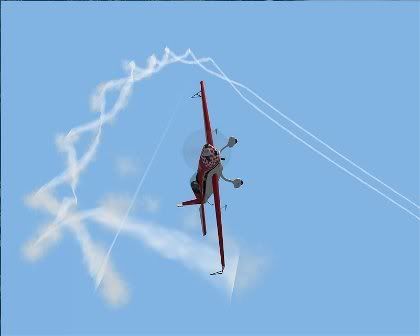
OK, got all that as I mount up. We trudge out the long march to runway in use 09 and take-off. She flies herself off as I set course to the north east for our favourite stomping ground around Evesham. Climb past the inversion layer at 3500’ to 5000’. A few puffy cumulus along the inversion layer, but some big clearings so no worries.
Usual HASELL checks and Max demonstrates the first one and talks it calmly through. All I can say is ‘Holy cr*p Batman’ as the world rotates rapidly around me with us in a steeply nose down position as I watch the ‘plug-hole effect exactly like he told me not to do – DOH!
‘OK – did you follow all that’ he asks as he climbs back up to height and explains what he did, when and why as I try desperately to clear my head and figure out what the hell happened – my first spin – WOW! ‘OK – do you fancy a go’ he asks about as casually as you would if you had just shown someone something on a spreadsheet! Someone else in the cockpit with a voice very similar to mine answered with a confident sounding ‘Yep – let’s give it a crack eh?’ – can’t have been me, I was still trying to figure out what the hell happened!
So I give it a go. A bit slower and more considered on the controls with a more sluggish entry and exit and some intervention from Max as a result. But I did the right things in the right sequence and even managed to look in the right direction this time, so I get the idea.
Anyway, we do a total of three (or maybe four) to the right then three to the left. I have to say, I really think I got it in the end there and began to lose my fear (but not my respect) for the spin and the recovery.
The cloud is starting to box us in and we are still with ¾ fuel – so no quick aeros, instead a steady crawl back to Gloucester for a standard overhead join for 09. Landed long on the runway (as is normal for 09 – or you have a long taxi to the exit and make the guy behind you go-around).
On taxi past the western apron, I noticed four Cabair DA40’s parked in formation. Max explained that on a day like this, the often sent studes out for their QXC one behind the other, so they could ‘follow’ each other on the radio.
Taxi in and shut down. Debrief was good. I really think I got it then and look forward to getting back to ‘normal’ aerobatics next time. But I have to say, I managed to get a nice headache and was wired on adrenaline for the next three hours. Spinning is pretty terrifying at first, but once you have got the hang of it, it’s just another aerobatic manoeuvre, albeit one that chews through the altitude.
Wow – really enjoying this stuff!!!
I rocked up at the airport to find a TV camera and loads of police wandering around. At first I thought it might be some sort of minor VIP arriving, but as I was checking the plane out, three police wandered past airside, so I asked them what was going on – ‘There’s a protest at the proposed runway extension and we think they might try a runway incursion’. What? All because Gloucester are extending the runway by some 20 metres and bulldozing the house at one end of the runway so they can get back some of the displaced threshold? Just how wrong can local NIMBY’s and so-called environmentalist’s get their facts? The will never be any 737’s in garish orange livery at Gloucester – chill! The runway is simply and never will be long enough!
Anyway, I check the plane and despite a clear note in the booking folder to leave it half-full maximum, some ‘helpful’ joker had filled it to the brim, thus making it too heavy for controlled aerobatics. I met Max and gave him the bad news, but he took it well – and in his finest Gloucestershire burr said ‘I knew that would happen sooner or later – but that’s OK, we can do spinning instead’. Apparently, the Robin won’t spin with less that ¾ of a tank.
So I had a good briefing from Max. The Robin is apparently very marginal and very hard to spin properly, so far so good I guess? Then he goes on to explain ‘…..and if you DO get it into a spin and hold it in for more than three rotations, the engine cuts out, so you have to exit the spin and restart the engine’!!!! Uhhhh – is it just me or doesn’t that sound too good? ‘Oh, it’s no problem, just press the restart button and it gets going again fine’. Yeah right!
So it also spins better to the right than to the left and if you don’t get it right, it will go into a spiral dive – c’mon Max, you’re just trying to cheer me up now!
So we go through the spin entry, which is power to 1800 and pull back in classic ‘slow flight’ manner until the stall warner, then progressive right rudder and pull fully back and away she goes. Hold it in the spin with rudder and back pressure, then recover on his command, probably after two rotations so the engine doesn’t cut by power off, then full (or near full) opposite rudder and unload the back pressure on the stick to neutral – wait for the spin to stop then pull to level - don’t push forward or you will push it past the vertical. Oh, and look up to the horizon to establish the spin direction, NOT along the line of the nose or you will get a ‘plug-hole’ effect and get mesmerised by the spin. Oh yes, and things will happen pretty quickly.

OK, got all that as I mount up. We trudge out the long march to runway in use 09 and take-off. She flies herself off as I set course to the north east for our favourite stomping ground around Evesham. Climb past the inversion layer at 3500’ to 5000’. A few puffy cumulus along the inversion layer, but some big clearings so no worries.
Usual HASELL checks and Max demonstrates the first one and talks it calmly through. All I can say is ‘Holy cr*p Batman’ as the world rotates rapidly around me with us in a steeply nose down position as I watch the ‘plug-hole effect exactly like he told me not to do – DOH!
‘OK – did you follow all that’ he asks as he climbs back up to height and explains what he did, when and why as I try desperately to clear my head and figure out what the hell happened – my first spin – WOW! ‘OK – do you fancy a go’ he asks about as casually as you would if you had just shown someone something on a spreadsheet! Someone else in the cockpit with a voice very similar to mine answered with a confident sounding ‘Yep – let’s give it a crack eh?’ – can’t have been me, I was still trying to figure out what the hell happened!
So I give it a go. A bit slower and more considered on the controls with a more sluggish entry and exit and some intervention from Max as a result. But I did the right things in the right sequence and even managed to look in the right direction this time, so I get the idea.
Anyway, we do a total of three (or maybe four) to the right then three to the left. I have to say, I really think I got it in the end there and began to lose my fear (but not my respect) for the spin and the recovery.
The cloud is starting to box us in and we are still with ¾ fuel – so no quick aeros, instead a steady crawl back to Gloucester for a standard overhead join for 09. Landed long on the runway (as is normal for 09 – or you have a long taxi to the exit and make the guy behind you go-around).
On taxi past the western apron, I noticed four Cabair DA40’s parked in formation. Max explained that on a day like this, the often sent studes out for their QXC one behind the other, so they could ‘follow’ each other on the radio.
Taxi in and shut down. Debrief was good. I really think I got it then and look forward to getting back to ‘normal’ aerobatics next time. But I have to say, I managed to get a nice headache and was wired on adrenaline for the next three hours. Spinning is pretty terrifying at first, but once you have got the hang of it, it’s just another aerobatic manoeuvre, albeit one that chews through the altitude.
Wow – really enjoying this stuff!!!
Monday, October 08, 2007
Aerobatics - Lesson 4.5
Fourth full lesson on aerobatics. The weather didn’t look too clever. Fully overcast, but not too low. Before setting out, I estimated cloudbase at anywhere between 3000’ and 3500’, so could be marginal whether I fly aerobatics or not.
Turned up and saw Max. He said the cloudbase was 3400’ and probably rising as the day wears on, so we should be OK – so out to check out the plane. Filled to just over ‘one tick’ on the gauge (four ticks is full). I checked with Max and he confirmed that with us two larger guys, that would be ideal. Usual start-up, taxy and take-off. Again headed to the ‘aerobatics playground’ to the north-easy, not far from Evesham. Base is at 3600’ but opoor horizon as it is fairly ‘high pressure murky’. Usual HASELL check and off we go.
Rolls
First one not so good, but I think due to a mis-understanding. He had told me earlier to pull up to 45 degrees and that is what I was doing checking the wing angle against the horizon. In fact it should be 30 degrees. Tried again with much better results. Now flying alternate left and right rolls so I don’t become ‘handed’ and always favour one side. I am feeling pretty comfortable with simple ballistic rolls now.
Loops
I am now flying all aspect of the loop, including judging when to pull the power. First loop was not great – I saw a clear roll angle relative to the horizon in the inverted. Max thought I had not pulled straight, apparently a common fault. Next loop was better, but we only just ‘got around’ as I didn’t pull hard enough at the start. It was also interesting as at the top of the loop we entered some cloud! The rest of the loops seemed OK. I think I am starting to get there slowly on these.
Stall Turns
First couple were Max doing the throttle and aileron and telling me when to hit the rudders. They went fine. Then as I hoped for, my turn to do the lot, including deciding when to reverse the rudder.
Off we went. Hard pull up to the vertical, full power then centralise pitch. Check vertical by reference to the angle of the horizon (such as it is) against the wing. Feed in more right rudder as the slipstream coils tighter around the fuselage with reduced airspeed. Am I out of right rudder? What’s next? Oh yes, hard reverse rudder to full left and simultaneous right aileron. Looking for the point at which the aircraft is horizontal (called ‘knife’), before pulling off the power and centralising controls for the vertical dive back down, then…...
……..WHAP!
I think the aircraft was coming around to ‘knife’ when very suddenly the ground and horizon did something very peculiar as it took a second or so to register with me – all I could think is a rather feeble ‘this isn’t normal!’. The aircraft had stalled part-way through and flicked onto it’s back and in a heartbeat we were nose straight down picking up speed. Before I could figure out what was happening and manfully chicken-out with a ‘you have control’, Max stepped in with an ‘I’ll take it’ and recovered.
OK – interesting that one!
Max explained that he had done so many stall turns that he found it fairly hard to deliberately cock them up to show students what to do when it goes ‘pear-shaped’, so he thought the best way was to give me a go! Well any time you want help screwing something up Max, just let me know – I’m your man!
Max explained that what had happened is that I was late in reversing the rudder and not quick enough in the reversal. As a result the aircraft had become too slow and had stalled part way around, flopped over on its back and headed vertically down. Max simply closed the throttle and carried out a standard pull to horizontal. I would probably have got there, but not before the aircraft ‘red-lined’!
OK, learned a lot there! I was thinking too hard and running what I was about to do through in my mind first causing me to be too leisurely about the whole thing. I am somewhat comforted by the AOPA book saying that the stall turn was probably the toughest of the basic moves. Well, I have a lot to learn yet, but got some valuable experience from that one.
On the 15 miles back to the airfield, the fuel light started to blink menacingly. Max was fine with it but did say when it went solid red, get a straight in approach and land immediately. As it happened, we were given a standard overhead join as the scheduled flight to the Isle of Man was landing. Max had me carry out a flapless landing what went pretty well, except that the Robin really does not have much room between the relatively slight nose-up flare required and scraping the tail protector, I can tell you!
Again, another good lesson from my point of view, not my performance you understand, but what I have learned.
Turned up and saw Max. He said the cloudbase was 3400’ and probably rising as the day wears on, so we should be OK – so out to check out the plane. Filled to just over ‘one tick’ on the gauge (four ticks is full). I checked with Max and he confirmed that with us two larger guys, that would be ideal. Usual start-up, taxy and take-off. Again headed to the ‘aerobatics playground’ to the north-easy, not far from Evesham. Base is at 3600’ but opoor horizon as it is fairly ‘high pressure murky’. Usual HASELL check and off we go.
Rolls
First one not so good, but I think due to a mis-understanding. He had told me earlier to pull up to 45 degrees and that is what I was doing checking the wing angle against the horizon. In fact it should be 30 degrees. Tried again with much better results. Now flying alternate left and right rolls so I don’t become ‘handed’ and always favour one side. I am feeling pretty comfortable with simple ballistic rolls now.
Loops
I am now flying all aspect of the loop, including judging when to pull the power. First loop was not great – I saw a clear roll angle relative to the horizon in the inverted. Max thought I had not pulled straight, apparently a common fault. Next loop was better, but we only just ‘got around’ as I didn’t pull hard enough at the start. It was also interesting as at the top of the loop we entered some cloud! The rest of the loops seemed OK. I think I am starting to get there slowly on these.
Stall Turns
First couple were Max doing the throttle and aileron and telling me when to hit the rudders. They went fine. Then as I hoped for, my turn to do the lot, including deciding when to reverse the rudder.
Off we went. Hard pull up to the vertical, full power then centralise pitch. Check vertical by reference to the angle of the horizon (such as it is) against the wing. Feed in more right rudder as the slipstream coils tighter around the fuselage with reduced airspeed. Am I out of right rudder? What’s next? Oh yes, hard reverse rudder to full left and simultaneous right aileron. Looking for the point at which the aircraft is horizontal (called ‘knife’), before pulling off the power and centralising controls for the vertical dive back down, then…...
……..WHAP!
I think the aircraft was coming around to ‘knife’ when very suddenly the ground and horizon did something very peculiar as it took a second or so to register with me – all I could think is a rather feeble ‘this isn’t normal!’. The aircraft had stalled part-way through and flicked onto it’s back and in a heartbeat we were nose straight down picking up speed. Before I could figure out what was happening and manfully chicken-out with a ‘you have control’, Max stepped in with an ‘I’ll take it’ and recovered.
OK – interesting that one!
Max explained that he had done so many stall turns that he found it fairly hard to deliberately cock them up to show students what to do when it goes ‘pear-shaped’, so he thought the best way was to give me a go! Well any time you want help screwing something up Max, just let me know – I’m your man!
Max explained that what had happened is that I was late in reversing the rudder and not quick enough in the reversal. As a result the aircraft had become too slow and had stalled part way around, flopped over on its back and headed vertically down. Max simply closed the throttle and carried out a standard pull to horizontal. I would probably have got there, but not before the aircraft ‘red-lined’!
OK, learned a lot there! I was thinking too hard and running what I was about to do through in my mind first causing me to be too leisurely about the whole thing. I am somewhat comforted by the AOPA book saying that the stall turn was probably the toughest of the basic moves. Well, I have a lot to learn yet, but got some valuable experience from that one.
On the 15 miles back to the airfield, the fuel light started to blink menacingly. Max was fine with it but did say when it went solid red, get a straight in approach and land immediately. As it happened, we were given a standard overhead join as the scheduled flight to the Isle of Man was landing. Max had me carry out a flapless landing what went pretty well, except that the Robin really does not have much room between the relatively slight nose-up flare required and scraping the tail protector, I can tell you!
Again, another good lesson from my point of view, not my performance you understand, but what I have learned.
Monday, October 01, 2007
Aerobatics - Lesson 3.5
The forecast didn’t look at all promising, but as ever in the UK, you really don’t know until the day itself. Looked out on Sunday morning and saw what looked like alto-stratus, fairly thin and I estimated at least 4000’ – so looks like I am on for aerobatics!
Rolled up for a 10:00 session and Max was on time as usual. Got another brief on – you guessed it, rolls, loops and stall turns!
Checked the aircraft out and cleared out all loose fittings – it wouldn’t do to have a fuel tester loose in the cockpit!
Started up and cleared to taxy. Minimal wind but runway 09 in use. Unusually, it was so quiet at Gloucester (despite the METAR giving CAVOK), that I was given a full backtrack on 09, with approval for power checks on the active runway itself – why so quiet?
Off we went and the Robin quite happily flew itself off as usual. Climbing at 75kts initially and set course for the north east and the lower land between the triangle formed by Bredon Hill, Evesham and Broadway – using the Toddington railway line as a linear feature to line up for the aerobatics.
We made 4000’ easily and I would guess there was another 1500’ before the thin cloudbase.
Rolls
First one not good. I didn’t pull up far enough and was a bit leisurely with full aileron input, so as a result, I was ‘punished’ with a significant nose down exit. On the up side, I knew what I had done wrong before I was half way around. Next roll of course I pulled too much, bled off too much airspeed and yes, nose down exit. But again, I knew what I had done. The next couple were good. Oh well! You learn more from your mistakes etc….
Loops
The first two were with me doing most of it, but with Max pulling the power off as we started to loop back down. Then the third loop, I got to do the whole thing myself – which I thought went well – certainly, I rolled out on the direction of the railway line I started on. I was warned to pay more attention to starting with wings level and pay more attention to keeping it that way.
Stall Turns
He is nursing me into this, and I can certainly see and understand what he is doing. But of course, there are quite a few things to do at the top of the climb in fairly rapid succession. I was doing the pull-ups and the vertical climb. On the last of them, I was whacking in full opposite left rudder when he told me to, to get used to the speed at which you have to do it. I fancy next time I’ll be doing most of it.
All too soon, back to the airfield, calms down a bit and get the ATIS. Given left base approach for 09 not below 1500, and slot in behind the PA28. I saw the PA28, (500’ below) which was a bit too close to slot in behind, so started an orbit. About half way around, there was a flexwing microlight, happy as larry, bimbling along the Severn at 1700’ (yes, inside the ATZ). So keeping a close eye on him, we orbited underneath. Hopefully he realised that bumbling around inside at ATZ of a busy airfield is not such a hot idea.
Back to the circuit and a nice floaty and slow landing, long on 09 to save the long taxy to the end.
Well, probably one step back then two forward this lesson. Rolls were not as good as last lesson until the last two, but then that is the nature of learning – certainly, I can now see what I am doing wrong and correct. I guess I would hate to ‘accidentally’ get it right every time, then when I solo, have it all go pear-shaped.
I will internalise all that I learned during the coming week by ‘flying at the coffee table’ – yep, with my eyes shut, hands on imaginary stick and throttle and feet pressing imaginary rudder bars and mouth mumbling through what I am doing. Give it a try – it really works.
Rolled up for a 10:00 session and Max was on time as usual. Got another brief on – you guessed it, rolls, loops and stall turns!
Checked the aircraft out and cleared out all loose fittings – it wouldn’t do to have a fuel tester loose in the cockpit!
Started up and cleared to taxy. Minimal wind but runway 09 in use. Unusually, it was so quiet at Gloucester (despite the METAR giving CAVOK), that I was given a full backtrack on 09, with approval for power checks on the active runway itself – why so quiet?
Off we went and the Robin quite happily flew itself off as usual. Climbing at 75kts initially and set course for the north east and the lower land between the triangle formed by Bredon Hill, Evesham and Broadway – using the Toddington railway line as a linear feature to line up for the aerobatics.
We made 4000’ easily and I would guess there was another 1500’ before the thin cloudbase.
Rolls
First one not good. I didn’t pull up far enough and was a bit leisurely with full aileron input, so as a result, I was ‘punished’ with a significant nose down exit. On the up side, I knew what I had done wrong before I was half way around. Next roll of course I pulled too much, bled off too much airspeed and yes, nose down exit. But again, I knew what I had done. The next couple were good. Oh well! You learn more from your mistakes etc….
Loops
The first two were with me doing most of it, but with Max pulling the power off as we started to loop back down. Then the third loop, I got to do the whole thing myself – which I thought went well – certainly, I rolled out on the direction of the railway line I started on. I was warned to pay more attention to starting with wings level and pay more attention to keeping it that way.
Stall Turns
He is nursing me into this, and I can certainly see and understand what he is doing. But of course, there are quite a few things to do at the top of the climb in fairly rapid succession. I was doing the pull-ups and the vertical climb. On the last of them, I was whacking in full opposite left rudder when he told me to, to get used to the speed at which you have to do it. I fancy next time I’ll be doing most of it.
All too soon, back to the airfield, calms down a bit and get the ATIS. Given left base approach for 09 not below 1500, and slot in behind the PA28. I saw the PA28, (500’ below) which was a bit too close to slot in behind, so started an orbit. About half way around, there was a flexwing microlight, happy as larry, bimbling along the Severn at 1700’ (yes, inside the ATZ). So keeping a close eye on him, we orbited underneath. Hopefully he realised that bumbling around inside at ATZ of a busy airfield is not such a hot idea.
Back to the circuit and a nice floaty and slow landing, long on 09 to save the long taxy to the end.
Well, probably one step back then two forward this lesson. Rolls were not as good as last lesson until the last two, but then that is the nature of learning – certainly, I can now see what I am doing wrong and correct. I guess I would hate to ‘accidentally’ get it right every time, then when I solo, have it all go pear-shaped.
I will internalise all that I learned during the coming week by ‘flying at the coffee table’ – yep, with my eyes shut, hands on imaginary stick and throttle and feet pressing imaginary rudder bars and mouth mumbling through what I am doing. Give it a try – it really works.
Sunday, September 23, 2007
Aerobatics - Lesson 2.5
Well, this is my third lesson, but the first lesson was only a half hour 'aerobatics experience', so call it 2.5!
The weather behaved again this weekend - just. I rocked up at the airfield watching nice big holes in the cloud disappear and wondered if we were on at all. Checked out G-BGBA, the Robin 2100 and climbed in with my instructor.
We took off from runway 22 at Gloucester and again headed for his favourite training area, the ‘bends in the river’ just south west of Gloucester.
There were no decent sized holes in the overcast, but it was higher than it looked. The Robin climbed gamely on at a stately 500 fpm as we climbed past 3000’. ‘Go for 4000’ if the overcast will let us’ Max said. At 3500’ it was clear that we would have the room and I levelled off at 4000’ with probably a couple of hundred feet to spare – phew!
On the menu today? Well, the basics again – ballistic rolls, loops and stall turns. Max’s way of teaching is to really cement things in and ‘layer’ things on as your confidence and experience grows.
First I do a ballistic roll to the left. I didn’t have enough of a climb angle and pay for it with the ‘sacred circle’ being just below the horizon. So I try again with a much better result. I do a third as Max wonders if it was a fluke, again with good results – I think I have got it, I really do.

The onto a couple of loops. First with me doing everything except pulling the power back crossing from inverted. He wants me to see when to do this. I spot it, it is basically when the nose of the aircraft passes back through the horizon into the green. We do another the same way. Then we do a third with me pulling the power back. On the last loop there was the distinctive 'bump' as we pulled back up to level flight of the aircraft going through it's own wake - I must be doing something right! I think I am not far from ‘getting’ the loop and feeling more comfortable with it.

Then we do some stall turns. I do the pull up and fly vertical, then Max takes over and talks me through and hand back control for me to recover to altitude. I can feel what he is doing and I think I understand it. I don’t do one myself this lesson, but I think I will be able to next lesson as the control movements are becoming clearer to me.

All too soon, we break off and Max give me a good tip – never charge back into the circuit immediately after aerobatics, give yourself 5 or 10 minutes to collect your thoughts and let the adrenaline come down a bit.
Standard overhead join for 22 as I fly the circuit and do one of the characteristic flatter landing in the Robin so as not to tailstrike. The attitude and method is very similar to the floatplane I flew in Canada earlier this year, a bit like a ‘three-pointer’ attitude you might fly in a taildragger. Good landing and taxy back.
I feel I am making progress and that Max will ‘layer’ more on and get me to do more ‘fine tuning’ on the basic moves. If the weather is good next time and we can get to 5000’, maybe some spins!
This aerobatics stuff really is huge fun – I find myself grinning like an idiot all the way home in the car!
The weather behaved again this weekend - just. I rocked up at the airfield watching nice big holes in the cloud disappear and wondered if we were on at all. Checked out G-BGBA, the Robin 2100 and climbed in with my instructor.
We took off from runway 22 at Gloucester and again headed for his favourite training area, the ‘bends in the river’ just south west of Gloucester.
There were no decent sized holes in the overcast, but it was higher than it looked. The Robin climbed gamely on at a stately 500 fpm as we climbed past 3000’. ‘Go for 4000’ if the overcast will let us’ Max said. At 3500’ it was clear that we would have the room and I levelled off at 4000’ with probably a couple of hundred feet to spare – phew!
On the menu today? Well, the basics again – ballistic rolls, loops and stall turns. Max’s way of teaching is to really cement things in and ‘layer’ things on as your confidence and experience grows.
First I do a ballistic roll to the left. I didn’t have enough of a climb angle and pay for it with the ‘sacred circle’ being just below the horizon. So I try again with a much better result. I do a third as Max wonders if it was a fluke, again with good results – I think I have got it, I really do.

The onto a couple of loops. First with me doing everything except pulling the power back crossing from inverted. He wants me to see when to do this. I spot it, it is basically when the nose of the aircraft passes back through the horizon into the green. We do another the same way. Then we do a third with me pulling the power back. On the last loop there was the distinctive 'bump' as we pulled back up to level flight of the aircraft going through it's own wake - I must be doing something right! I think I am not far from ‘getting’ the loop and feeling more comfortable with it.

Then we do some stall turns. I do the pull up and fly vertical, then Max takes over and talks me through and hand back control for me to recover to altitude. I can feel what he is doing and I think I understand it. I don’t do one myself this lesson, but I think I will be able to next lesson as the control movements are becoming clearer to me.

All too soon, we break off and Max give me a good tip – never charge back into the circuit immediately after aerobatics, give yourself 5 or 10 minutes to collect your thoughts and let the adrenaline come down a bit.
Standard overhead join for 22 as I fly the circuit and do one of the characteristic flatter landing in the Robin so as not to tailstrike. The attitude and method is very similar to the floatplane I flew in Canada earlier this year, a bit like a ‘three-pointer’ attitude you might fly in a taildragger. Good landing and taxy back.
I feel I am making progress and that Max will ‘layer’ more on and get me to do more ‘fine tuning’ on the basic moves. If the weather is good next time and we can get to 5000’, maybe some spins!
This aerobatics stuff really is huge fun – I find myself grinning like an idiot all the way home in the car!
Monday, September 17, 2007
More Aerobatics
After my first formal (but somewhat short) aerobatics lesson last weekend, I spent most of the next week in the office looking at perfect flying weather. This year in the UK has been abysmal weather-wise as the jetstream was not forced north in the summer as it usually is until about September! I have been looking forward to my second lesson, where Max said that if the weather was up to it we would do ‘some spinning’.
The weather on Sunday was OK-ish. Quite gusty and varying from scattered but fairly well developed cumulus to near overcast. My lesson was at 16:00, so I made my way to the airfield in the afternoon. The weather looked good enough with a few large ‘holes’ in the cloud we could probably use.
Max arrived and gave me a longer briefing, but not spinning today, we would again concentrate on the basics, loop, roll and a few more stall turns. I had read the book he supplied and we discussed the ‘sacred circle’ that the nose of the aircraft describes relative to the horizon during a roll. A lot more discussion on rudder usage which ties back in to the primary and secondary effect of controls that I learned on the basic PPL – it really comes into its own here as we will be carrying out many moves at low airspeed and high engine power.
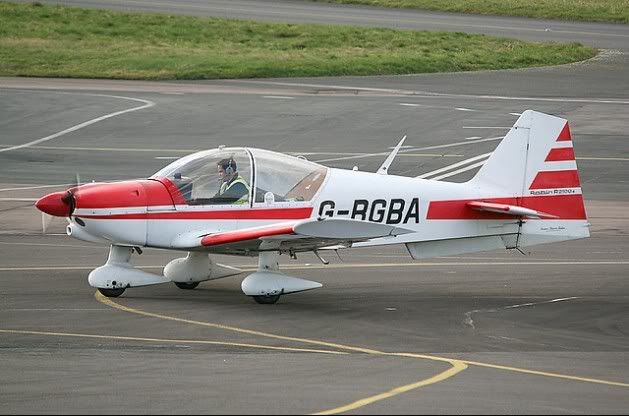
It was the older Robin 2100 this time, G-BGBA. I grabbed a checklist and did a proper ‘by the book’ walkaround. We emptied loose articles in the aircraft (a fuel drain tester loosely stowed in a semi-enclosed shelf would have made a nice missile rattling around the cockpit and would inevitably try to wedge itself in the root of the control stick!).
We climbed in and I started up, again by the book. It is always fun hunting around the panel for unfamiliar switches and uniquely French ways of doing things – this is only the second time I have flown a Robin, so a learning experience until things start to ‘fall to hand’. The aircraft was left half-full of fuel, which put us in the ‘aerobatics’ weight and balance category. So off we trundled.
I was conscious of the fact I was with an instructor, so I deliberately slowed my taxy speed down to the ‘officially approved’ fast walking pace – we all pick up bad habits and I guess a reasonably brisk taxy speed is a common one.
E2 for 22 was the hold as I did the power checks and pre-take off’s. ‘It’s not so much a rotate speed as it starts flying’ Max advised, warning again about avoiding Cessna type angles of attack close to the ground and the likelihood of a tailstrike in the Robin. So off we went, she picked up speed reasonably and as advertised, started to get ‘floaty’ then flew itself off. Climb at 75 kts to 300’ AGL then FEAT – Flaps, Engine, Attitude, Trim.
Climb at 75 kts on extended runway heading, so to the south west over Gloucester. I eventually got to a nice hole in the clouds at 4000’, pretty much over the ‘bends in the river’ on the Severn south-west of Gloucester. A good HASELLL check, transponder to 7004 and we are set to go.
First up is a ballistic roll to the left. This I do with the standard entry to 110 kts, stabalise then pull up to about 45 degrees, check to neutral pitch then ailerons fully over as the ground rotates around me. I looked carefully at the circle described by the nose of the aircraft, some of which was below the horizon. Roll out, regain 110, hard climb as speed bleeds back to 80 kts, then full power and nose down to a full power climb at 70 kts.
A few mistakes to work on. I am not quite getting the nose high enough to start, also I am not properly checking the pitch so enter the roll with back pressure and finally, rolling out a little too soon.
We do a few more over the space of the lesson and I pretty much get it all now, but not 100% yet on checking the pitch. I think it is a lack of confidence that I have attained the correct pitch. The way Max is teaching me is to stick with the basics until I have them through my head, then to ‘layer in’ other stuff until I put it all together. So once I have the ballistic roll off pat, I will go onto barrel roll’s and ailerons rolls and bring in the elements of rudder. Sounds like a good plan.
The loops were great fun. I started doing the pull up to vertical, then Max would take over and talk through what he was doing which I would mimic. By the end of the loops, I was doing all of the stick-work, but Max was still controlling the power. I have got the idea of looking at each wingtip on the pull-up and seem to be pulling up properly (i.e. not favouring one side or the other). I am looking up and over for the reappearance of the ground in the inverted. I have got the hang of easing back to near neutral in the inverted but I am maybe a bit slow to pull out in the vertical downwards.
I realise that Max is not troubling me with rudder inputs, as I can see the effect in the vertical of not doing this. I suspect he will cover this next time as he ‘layer more on’.
Max demonstrates the stall turn probably three or four times. There seems a fair bit to remember here, but I am starting to get the idea of what he is doing and hopefully I won’t cock it up too much when I try it.
Probably to test me out, Max gives me a mild dose of negative ‘G’ with a ‘half Cuban’ – with both of us suspended by the straps inverted for several seconds while bits of dirt and dead flies flutter ‘down’ to the top of the canopy – the quote from Top Gun occurs to me:
‘…….is this your idea of fun Mav?’
OK, this is hardly an F14, but you get the idea! Anyway, no problem with me with negative g.
Max asked me several times if I was OK and explained that repeated g forces make you tired and when tired, your concentration driops off and you learn less etc. I reassure him I am not the least bit tired (too much adrenaline) and I am fine with the g.
We head back to Gloucester and I take the plane for a standard overhead join for 22 and land off right hand circuits. The landing is pretty good and I keep a relatively shallow angle (as opposed to the normal ‘fully stalled’ landing) to avoid tailstrike. I think I am getting a feel for the aircraft, after all it is a pretty simple aircraft, it’s just where everything is and flying a stick as opposed to a yoke.
We taxy back and debrief. Next lesson, next Saturday at 16:00. If the weather is good, spins and if not, then a formal check-out on the type with PFL’s, steep turns, slow flight and circuits etc.
I only hope the weather holds for the next couple of months – probably a forlorn hope!
The weather on Sunday was OK-ish. Quite gusty and varying from scattered but fairly well developed cumulus to near overcast. My lesson was at 16:00, so I made my way to the airfield in the afternoon. The weather looked good enough with a few large ‘holes’ in the cloud we could probably use.
Max arrived and gave me a longer briefing, but not spinning today, we would again concentrate on the basics, loop, roll and a few more stall turns. I had read the book he supplied and we discussed the ‘sacred circle’ that the nose of the aircraft describes relative to the horizon during a roll. A lot more discussion on rudder usage which ties back in to the primary and secondary effect of controls that I learned on the basic PPL – it really comes into its own here as we will be carrying out many moves at low airspeed and high engine power.

It was the older Robin 2100 this time, G-BGBA. I grabbed a checklist and did a proper ‘by the book’ walkaround. We emptied loose articles in the aircraft (a fuel drain tester loosely stowed in a semi-enclosed shelf would have made a nice missile rattling around the cockpit and would inevitably try to wedge itself in the root of the control stick!).
We climbed in and I started up, again by the book. It is always fun hunting around the panel for unfamiliar switches and uniquely French ways of doing things – this is only the second time I have flown a Robin, so a learning experience until things start to ‘fall to hand’. The aircraft was left half-full of fuel, which put us in the ‘aerobatics’ weight and balance category. So off we trundled.
I was conscious of the fact I was with an instructor, so I deliberately slowed my taxy speed down to the ‘officially approved’ fast walking pace – we all pick up bad habits and I guess a reasonably brisk taxy speed is a common one.
E2 for 22 was the hold as I did the power checks and pre-take off’s. ‘It’s not so much a rotate speed as it starts flying’ Max advised, warning again about avoiding Cessna type angles of attack close to the ground and the likelihood of a tailstrike in the Robin. So off we went, she picked up speed reasonably and as advertised, started to get ‘floaty’ then flew itself off. Climb at 75 kts to 300’ AGL then FEAT – Flaps, Engine, Attitude, Trim.
Climb at 75 kts on extended runway heading, so to the south west over Gloucester. I eventually got to a nice hole in the clouds at 4000’, pretty much over the ‘bends in the river’ on the Severn south-west of Gloucester. A good HASELLL check, transponder to 7004 and we are set to go.
First up is a ballistic roll to the left. This I do with the standard entry to 110 kts, stabalise then pull up to about 45 degrees, check to neutral pitch then ailerons fully over as the ground rotates around me. I looked carefully at the circle described by the nose of the aircraft, some of which was below the horizon. Roll out, regain 110, hard climb as speed bleeds back to 80 kts, then full power and nose down to a full power climb at 70 kts.
A few mistakes to work on. I am not quite getting the nose high enough to start, also I am not properly checking the pitch so enter the roll with back pressure and finally, rolling out a little too soon.
We do a few more over the space of the lesson and I pretty much get it all now, but not 100% yet on checking the pitch. I think it is a lack of confidence that I have attained the correct pitch. The way Max is teaching me is to stick with the basics until I have them through my head, then to ‘layer in’ other stuff until I put it all together. So once I have the ballistic roll off pat, I will go onto barrel roll’s and ailerons rolls and bring in the elements of rudder. Sounds like a good plan.
The loops were great fun. I started doing the pull up to vertical, then Max would take over and talk through what he was doing which I would mimic. By the end of the loops, I was doing all of the stick-work, but Max was still controlling the power. I have got the idea of looking at each wingtip on the pull-up and seem to be pulling up properly (i.e. not favouring one side or the other). I am looking up and over for the reappearance of the ground in the inverted. I have got the hang of easing back to near neutral in the inverted but I am maybe a bit slow to pull out in the vertical downwards.
I realise that Max is not troubling me with rudder inputs, as I can see the effect in the vertical of not doing this. I suspect he will cover this next time as he ‘layer more on’.
Max demonstrates the stall turn probably three or four times. There seems a fair bit to remember here, but I am starting to get the idea of what he is doing and hopefully I won’t cock it up too much when I try it.
Probably to test me out, Max gives me a mild dose of negative ‘G’ with a ‘half Cuban’ – with both of us suspended by the straps inverted for several seconds while bits of dirt and dead flies flutter ‘down’ to the top of the canopy – the quote from Top Gun occurs to me:
‘…….is this your idea of fun Mav?’
OK, this is hardly an F14, but you get the idea! Anyway, no problem with me with negative g.
Max asked me several times if I was OK and explained that repeated g forces make you tired and when tired, your concentration driops off and you learn less etc. I reassure him I am not the least bit tired (too much adrenaline) and I am fine with the g.
We head back to Gloucester and I take the plane for a standard overhead join for 22 and land off right hand circuits. The landing is pretty good and I keep a relatively shallow angle (as opposed to the normal ‘fully stalled’ landing) to avoid tailstrike. I think I am getting a feel for the aircraft, after all it is a pretty simple aircraft, it’s just where everything is and flying a stick as opposed to a yoke.
We taxy back and debrief. Next lesson, next Saturday at 16:00. If the weather is good, spins and if not, then a formal check-out on the type with PFL’s, steep turns, slow flight and circuits etc.
I only hope the weather holds for the next couple of months – probably a forlorn hope!
Thursday, September 13, 2007
Canada Touring?
My ‘bestest buddy in the whole-wide-world’ (so he tells me!) lives in Ottawa. We like to meet up at least once and better still twice a year. Me being a pilot and him a keen wannabe, I also like to tie one of these visits in with some serious touring, a few sights and lots of beer.
For 2008 I may well visit Canada twice, once in February for a week for winter sport (and the famous Ottawa ‘Winterlude’) and maybe for a week in late summer for a flying trip, renting a plane from somewhere in Ottawa. The only snag is that I don’t have a Canadian licence! I have a JAA PPL and a full FAA certificate, but no Canadian one.
The ever useful Flyer Forum helped a lot when I asked for advice. It seemed that the best options were either:
1. Go the JAA route.
2. Go the FAA route.
The JAA route would entail me taking the full Canadian multi-choice Transport Canada exam, then carrying out a full flight skill test.
The FAA route had changed at the end of 2006 and now meant that all I would have to do is shortened exam which focused on the differences between the FAA and Canadian regulations and fill out lots of bits of paper.
No contest – I would go the FAA route. No flight test and cheaper.
My FAA medical is and will be still in date. Only drawback is that I got my FAA ticket over three years ago and am now overdue for a BFR. So what I will do is a BFR here in the UK before Christmas, then sort the formalities at my chosen flying club in Ottawa when I get there in February. I have found a spoke to a suitable FAA examiner here in the UK and he is only in Oxford, so that shouldn’t be a problem. Of course while I am in Ottawa, I will take a plane up anyway (with an instructor) for a bit of fun in February.
This will mean that I will get my Canadian licence sorted out by March 2008, in plenty of time for aircraft hire from Ottawa for late summer 2008.
I have also had an email conversation with Rockcliffe Flying Club who were extremely helpful. The confirmed that I could do all the formalities there and subject to a checkride, could hire one of their C172s for a few days and take it into the USA if I wanted to do this. There is a minimum 3 hours per day but they indicated some flexibility over this.

So maybe there will be two decent tours for me in 2008, one in Europe with my wife and one in Canada with my buddy.
I don’t want to get ahead of myself here, but I am already dreaming up a roundtrip – maybe the Atlantic provinces of Canada or maybe New York to visit my sister and stooge around the USA and back via Toronto. I’ll talk it through with the guys at Rockcliffe, see if they have any ideas – nice problems to have!
For 2008 I may well visit Canada twice, once in February for a week for winter sport (and the famous Ottawa ‘Winterlude’) and maybe for a week in late summer for a flying trip, renting a plane from somewhere in Ottawa. The only snag is that I don’t have a Canadian licence! I have a JAA PPL and a full FAA certificate, but no Canadian one.
The ever useful Flyer Forum helped a lot when I asked for advice. It seemed that the best options were either:
1. Go the JAA route.
2. Go the FAA route.
The JAA route would entail me taking the full Canadian multi-choice Transport Canada exam, then carrying out a full flight skill test.
The FAA route had changed at the end of 2006 and now meant that all I would have to do is shortened exam which focused on the differences between the FAA and Canadian regulations and fill out lots of bits of paper.
No contest – I would go the FAA route. No flight test and cheaper.
My FAA medical is and will be still in date. Only drawback is that I got my FAA ticket over three years ago and am now overdue for a BFR. So what I will do is a BFR here in the UK before Christmas, then sort the formalities at my chosen flying club in Ottawa when I get there in February. I have found a spoke to a suitable FAA examiner here in the UK and he is only in Oxford, so that shouldn’t be a problem. Of course while I am in Ottawa, I will take a plane up anyway (with an instructor) for a bit of fun in February.
This will mean that I will get my Canadian licence sorted out by March 2008, in plenty of time for aircraft hire from Ottawa for late summer 2008.
I have also had an email conversation with Rockcliffe Flying Club who were extremely helpful. The confirmed that I could do all the formalities there and subject to a checkride, could hire one of their C172s for a few days and take it into the USA if I wanted to do this. There is a minimum 3 hours per day but they indicated some flexibility over this.

So maybe there will be two decent tours for me in 2008, one in Europe with my wife and one in Canada with my buddy.
I don’t want to get ahead of myself here, but I am already dreaming up a roundtrip – maybe the Atlantic provinces of Canada or maybe New York to visit my sister and stooge around the USA and back via Toronto. I’ll talk it through with the guys at Rockcliffe, see if they have any ideas – nice problems to have!
Monday, September 10, 2007
Aerobatics Training
I have been thinking about some formal aerobatics training for some time now. I have flown aerobatics, but only on ‘extra special treat’ type flights on three occasions now. Once, before I learned to fly, in a Jet Provost at Norwich, then once I had passed my PPL, an awesome days flying with Air Combat in LA in an Extra 300. More recently, in a T6 Harvard at Shoreham. That, and the opportunity to fly and be checked out in an aircraft that I haven’t flown yet, proved to be sufficient incentive to give it a go.
Next questions is where? I checked with a few people I know, and they unanimously agreed that ‘Ultimate High’ in Kemble were the dogs b*ll*cks.
I spoke to Ultimate High and yes, they do the AOPA course, but really only as a four day intensive programme on Monday to Thursday, with two sorties a day in a Bulldog. I would have been very happy with this, but just one snag…. I don’t have enough holiday this year and probably won’t next year either!
So plan B. My preferred local flying club, Cotswold Aero Club (based at Gloucester), do the AOPA Basic Aerobatics certificate, albeit in a Robin R2112 (not as nice apparently as a Bulldog). However, I could do this at weekends as and when I could find a training slot, so this looked just the ticket.
I booked what I thought was the first full lesson of the AOPA certificate, but the lady I spoke to assumed I only wanted an ‘aerobatic experience’ and only booked a half hour slot, so that was disappointing, but not the end of the world.
I didn’t see Max first, instead I saw a student he had just finished with (or probably an air-experience ‘victim’) wander unsteadily back to the club looking somewhat the worse for wear. ‘Did you enjoy it?’ his friend asked sticking a video camera into his face from short range, grinning. ‘Uh, yeah, uh sort of, yeah I guess so’ said the ‘victim’ as his eyes wobbled visibly like a cartoon character! ‘I thought it might be cold up there, mebbe I shouldn’t have worn the extra sweatshirt’ he rationalised. Thinks hmmmm….. aerobatics and feeling warm? Not a good combination – I suspect he ‘tossed his cookies’.
My instructor introduced himself as Max and briefed me on the three manoeuvres we would be looking at – the ballistic roll, loop and stall turn. He talked through the limiting RPM (actually a speed at this is not a VP aircraft), the entry technique and what to do at each stage.
Max gently enquires what experience I have and in particular what experience I have had of positive and negative ‘G’. Like a sensible aerobatics instructor, he is digging for how likely I am to ‘toss my cookies’ and therefore how readily available he needs to have a sickbag! I reassure him on this front that I have not yet ‘lost it’ with my limited but relevant aerobatics experience at the hands of a couple of people, including Air Combat USA in the mighty Extra 300 (closes eyes briefly as I think back to that great day two years ago or so).
Then off we went. As I am also new to the Robin, he saved time and started up, taxied out and did the take-off. I took over in the climb as we climbed at a not very impressive 500fpm at 75 kts.
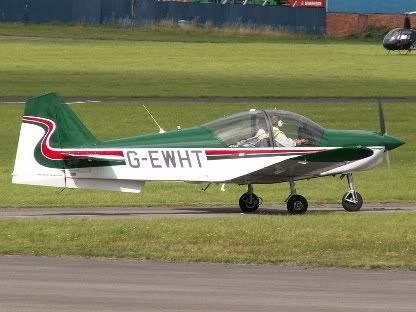
We climbed and headed for the best of the weather to the north east around Bredon Hill and Damien Hirst’s house along the Cotswold ridge. He explained that he was cleared for aerobatics to well below 3000’, but that I must treat 3000’ as the ‘hard deck’ and never finish aeros below this height (to allow enough room to recover if it all goes pear-shaped).
We got to altitude and Max first showed me the ballistic roll. He explained that this was not an aileron roll, nor a barrel roll, but a bit of a mixture of the two, with an almost bullet-like movement about the longitudinal axis. First he showed me twice then I copied with a couple of rolls to the left. First the HASELLL check, then standard entry.
Standard entry consists of throttle to 2300 rpm, then nose down attitude to get 110 kts (from a rather stately cruise of 80 kts!), nose up a bit to an attitude that maintains 110 kts – this is basically the standard entry for all the simple manoeuvres I would be trained on.
From the standard entry, nose up sharply then stick fully over to the left and hold while the ground rotates around you (bizarre, but that’s how it feels!). Hold it hard over until the ground is the right way up, then stop the roll. The nose will be down by now and assuming the attitude to maintain 110 kts – so basically back to the standard entry position (this is quite deliberate as it means you can go straight into another manoeuvre in a sequence (altitude permitting of course!).
That was fun. If anything on one of them, he thought I rolled out a bit early, but said that was a typical beginners mistake.
Then onto a loop. He talked me through it again and demonstrated two. I didn’t have a go as we were again tight for time. Instead (probably due to the altitude loss and the time to climb back up) I did another roll.
All too soon, we had to head back. But on the way back, he demonstrated two ‘stall turns’ (aka Hammerhead in the USA). Basically this consists of a standard entry, followed by a pull up to the vertical, with rudder one way and ailerons the other (IIRC) as the plane then turns left or right at the top of the vertical until it is pointed straight down.
WOW!!!!!!! REALLY ENJOYED THAT ONE!!!!!
Unfortunately, that’s all we have time for, so back in the circuit as he hands over to me to land from late downwind. I am initially confused as I have been flying a stick aircraft with my right hand and using the vernier throttle on the left with my left hand (the Robin has two throttle). Now I have to fiddle with trim and carb heat on the right. The trick is apparently to fly aeros with the right hand, but in the circuit with your left hand – OK, cool – all part of learning a different aircraft.
I wander a bit on base as I get the fell for the plane and the power settings, height loss, trim etc. I get set up at the required 65kts approach speed for runway 09. He again warns me NOT to try the ‘nose high – stall buzzer’ landing common in most training aircraft as the Robins are very easy to tail-strike. I land at a shallower angle than normal and as we fast taxi with the nose in the air, Max shows me how easy it is to tail-strike (there is of course a protective tailskid). I am amazed at how easy it is to do – lesson rammed home I guess.
Park up and shut down as he charges off to prep another student, I head back to the clubhouse and complete the logs and bills etc. I get a debrief and book the next lesson – a full one this time next Sunday at 16:00 (very few slots in the aircraft left by then). He says next time, weather permitting, well do spins and spin recovery (which, like most UK PPL’s, I have never done).
I buy a specific aerobatics book that Max prefers from him and of course trot into Transair next door to buy another (the AOPA basic aerobatics book).
THAT’S IT! I’M HOOKED!!!!!
I will do the AOPA basic certificate and aim to do aeros on my own (or with a passenger of course) by renting the Robin, in addition to flying a non-aerobatic share (of course a share in an aerobatic plane that can also tour would be ideal, but none of those at Gloucester – where is a Bulldog when you need one?).
Next questions is where? I checked with a few people I know, and they unanimously agreed that ‘Ultimate High’ in Kemble were the dogs b*ll*cks.
I spoke to Ultimate High and yes, they do the AOPA course, but really only as a four day intensive programme on Monday to Thursday, with two sorties a day in a Bulldog. I would have been very happy with this, but just one snag…. I don’t have enough holiday this year and probably won’t next year either!
So plan B. My preferred local flying club, Cotswold Aero Club (based at Gloucester), do the AOPA Basic Aerobatics certificate, albeit in a Robin R2112 (not as nice apparently as a Bulldog). However, I could do this at weekends as and when I could find a training slot, so this looked just the ticket.
I booked what I thought was the first full lesson of the AOPA certificate, but the lady I spoke to assumed I only wanted an ‘aerobatic experience’ and only booked a half hour slot, so that was disappointing, but not the end of the world.
I didn’t see Max first, instead I saw a student he had just finished with (or probably an air-experience ‘victim’) wander unsteadily back to the club looking somewhat the worse for wear. ‘Did you enjoy it?’ his friend asked sticking a video camera into his face from short range, grinning. ‘Uh, yeah, uh sort of, yeah I guess so’ said the ‘victim’ as his eyes wobbled visibly like a cartoon character! ‘I thought it might be cold up there, mebbe I shouldn’t have worn the extra sweatshirt’ he rationalised. Thinks hmmmm….. aerobatics and feeling warm? Not a good combination – I suspect he ‘tossed his cookies’.
My instructor introduced himself as Max and briefed me on the three manoeuvres we would be looking at – the ballistic roll, loop and stall turn. He talked through the limiting RPM (actually a speed at this is not a VP aircraft), the entry technique and what to do at each stage.
Max gently enquires what experience I have and in particular what experience I have had of positive and negative ‘G’. Like a sensible aerobatics instructor, he is digging for how likely I am to ‘toss my cookies’ and therefore how readily available he needs to have a sickbag! I reassure him on this front that I have not yet ‘lost it’ with my limited but relevant aerobatics experience at the hands of a couple of people, including Air Combat USA in the mighty Extra 300 (closes eyes briefly as I think back to that great day two years ago or so).
Then off we went. As I am also new to the Robin, he saved time and started up, taxied out and did the take-off. I took over in the climb as we climbed at a not very impressive 500fpm at 75 kts.

We climbed and headed for the best of the weather to the north east around Bredon Hill and Damien Hirst’s house along the Cotswold ridge. He explained that he was cleared for aerobatics to well below 3000’, but that I must treat 3000’ as the ‘hard deck’ and never finish aeros below this height (to allow enough room to recover if it all goes pear-shaped).
We got to altitude and Max first showed me the ballistic roll. He explained that this was not an aileron roll, nor a barrel roll, but a bit of a mixture of the two, with an almost bullet-like movement about the longitudinal axis. First he showed me twice then I copied with a couple of rolls to the left. First the HASELLL check, then standard entry.
Standard entry consists of throttle to 2300 rpm, then nose down attitude to get 110 kts (from a rather stately cruise of 80 kts!), nose up a bit to an attitude that maintains 110 kts – this is basically the standard entry for all the simple manoeuvres I would be trained on.
From the standard entry, nose up sharply then stick fully over to the left and hold while the ground rotates around you (bizarre, but that’s how it feels!). Hold it hard over until the ground is the right way up, then stop the roll. The nose will be down by now and assuming the attitude to maintain 110 kts – so basically back to the standard entry position (this is quite deliberate as it means you can go straight into another manoeuvre in a sequence (altitude permitting of course!).
That was fun. If anything on one of them, he thought I rolled out a bit early, but said that was a typical beginners mistake.
Then onto a loop. He talked me through it again and demonstrated two. I didn’t have a go as we were again tight for time. Instead (probably due to the altitude loss and the time to climb back up) I did another roll.
All too soon, we had to head back. But on the way back, he demonstrated two ‘stall turns’ (aka Hammerhead in the USA). Basically this consists of a standard entry, followed by a pull up to the vertical, with rudder one way and ailerons the other (IIRC) as the plane then turns left or right at the top of the vertical until it is pointed straight down.
WOW!!!!!!! REALLY ENJOYED THAT ONE!!!!!
Unfortunately, that’s all we have time for, so back in the circuit as he hands over to me to land from late downwind. I am initially confused as I have been flying a stick aircraft with my right hand and using the vernier throttle on the left with my left hand (the Robin has two throttle). Now I have to fiddle with trim and carb heat on the right. The trick is apparently to fly aeros with the right hand, but in the circuit with your left hand – OK, cool – all part of learning a different aircraft.
I wander a bit on base as I get the fell for the plane and the power settings, height loss, trim etc. I get set up at the required 65kts approach speed for runway 09. He again warns me NOT to try the ‘nose high – stall buzzer’ landing common in most training aircraft as the Robins are very easy to tail-strike. I land at a shallower angle than normal and as we fast taxi with the nose in the air, Max shows me how easy it is to tail-strike (there is of course a protective tailskid). I am amazed at how easy it is to do – lesson rammed home I guess.
Park up and shut down as he charges off to prep another student, I head back to the clubhouse and complete the logs and bills etc. I get a debrief and book the next lesson – a full one this time next Sunday at 16:00 (very few slots in the aircraft left by then). He says next time, weather permitting, well do spins and spin recovery (which, like most UK PPL’s, I have never done).
I buy a specific aerobatics book that Max prefers from him and of course trot into Transair next door to buy another (the AOPA basic aerobatics book).
THAT’S IT! I’M HOOKED!!!!!
I will do the AOPA basic certificate and aim to do aeros on my own (or with a passenger of course) by renting the Robin, in addition to flying a non-aerobatic share (of course a share in an aerobatic plane that can also tour would be ideal, but none of those at Gloucester – where is a Bulldog when you need one?).
Monday, August 06, 2007
Big Trip 2007 - Reprise
Well, that is my ‘big trip’ for 2007. This year, I had to ‘pivot’ around seeing our friend and neighbour in Lausanne, Switzerland. A quick look at the map for the one week trip showed the options to be limited, given that we wanted to spend at least one, preferably two days in each location and to try to avoid two leg days.
Given these constraints, I decided on Koblenz (as I had heard so much about it) and Dan fancied Chateau Chambord, so Blois in the Loire Valley was the other destination.
With hindsight, we didn’t need as many days in Koblenz and could have tried for a night somewhere else in Germany headed towards Switzerland, but there you go.
I accumulated to total of 9 hours ‘loggable’ flying time over a total of four legs over one week. The longest leg was just over 2.5 hours and there was plenty of fuel left. I would be quite confident of flying a three hour or a three-and-a-bit hour leg in the Bonanza now (yes, its got a fuel flow wotsit, but it is a real confidence builder to eyeball and dip the remaining fuel).
This was the first time I have flown in a small plane to either Germany or Switzerland and certainly my first time getting up close and personal to some serious mountains.
All in all, it was a great trip. Maybe not a ‘epic’ as the 2006 Flyer Forum trip to Italy, but then it was never planned to be.
Well since Dan is ‘banned’ from coming back to Europe next year without his wife and I don’t want to play ‘gooseberry’, I think my big trip next year may have to be with my wife (she might come) or maybe a fellow pilot. I’ll look out to see what Flyer Forum may have planned and maybe hook up with that. Mind you, the wife is talking about a tour of northern Spain, so flying may be a good option. Wait and see really.
I hope to get a trip to Deauville / Honfleur with the wife and may try to take my neighbour on a battlefields tour of the Normandy beaches.
Given these constraints, I decided on Koblenz (as I had heard so much about it) and Dan fancied Chateau Chambord, so Blois in the Loire Valley was the other destination.
With hindsight, we didn’t need as many days in Koblenz and could have tried for a night somewhere else in Germany headed towards Switzerland, but there you go.
I accumulated to total of 9 hours ‘loggable’ flying time over a total of four legs over one week. The longest leg was just over 2.5 hours and there was plenty of fuel left. I would be quite confident of flying a three hour or a three-and-a-bit hour leg in the Bonanza now (yes, its got a fuel flow wotsit, but it is a real confidence builder to eyeball and dip the remaining fuel).
This was the first time I have flown in a small plane to either Germany or Switzerland and certainly my first time getting up close and personal to some serious mountains.
All in all, it was a great trip. Maybe not a ‘epic’ as the 2006 Flyer Forum trip to Italy, but then it was never planned to be.
Well since Dan is ‘banned’ from coming back to Europe next year without his wife and I don’t want to play ‘gooseberry’, I think my big trip next year may have to be with my wife (she might come) or maybe a fellow pilot. I’ll look out to see what Flyer Forum may have planned and maybe hook up with that. Mind you, the wife is talking about a tour of northern Spain, so flying may be a good option. Wait and see really.
I hope to get a trip to Deauville / Honfleur with the wife and may try to take my neighbour on a battlefields tour of the Normandy beaches.
Sunday, August 05, 2007
Big Trip 2007 - Le Touquet to Gloucester
1.6 hours logged
LFAT DCT ALESO DCT SFD DCT GWC DCT EGBJ
Well I have done this route a few times now! The weather was excellent, clear skies and probably the best visibility I have ever seen over the channel.
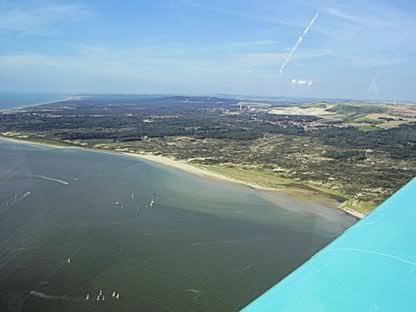
Took off and climbed to 4500’ and proceeded to sit there for the whole trip. I was expecting clouds over the UK and that is what it looked like, but it was only the effect of looking ‘edge-on’ at the cloud layer, when I got to where the clouds should be, they weren’t there, but further on and so on.
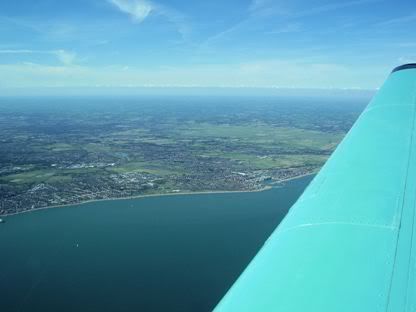
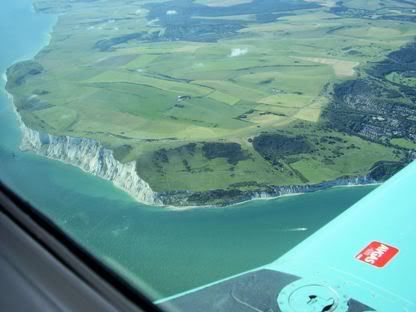
Farnborough Radar were frantically busy and I barely managed to get the call in. I really do take my hat off to UK controllers – they do a fantastic job (oh, and Langen Info as well, although they were far from busy).
Asked for and got a transit through the western edge of Brize Zone to stay well clear of parachuting at South Cerney.
Check the Gloucester ATIS and got a standard overhead join for 27. Good approach, but a bit fast and was penalised with a ‘floaty’ hold-off and a landing past the first intersection.
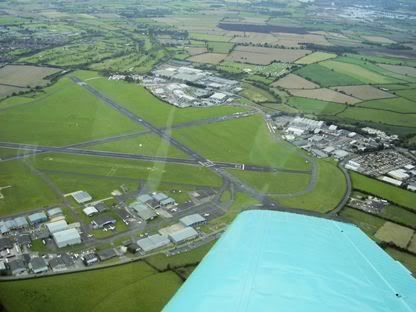
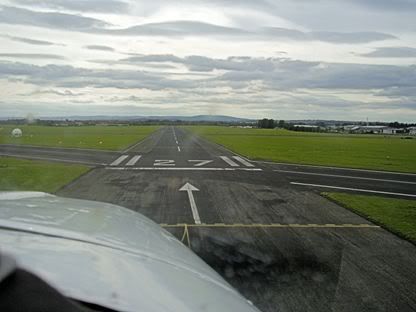
We parked up and pushed back into the hangar. While I completed the logs and other formalities, Dan unloaded and cleaned to perspex and leading edges of the wings (by now these we covered in fly-splats).
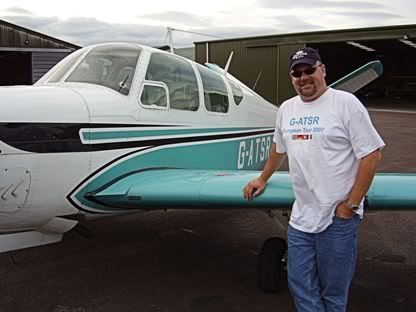
The very nice lady on reception at Gloucester was quite taken with our, by now pretty smelly, team t-shirts and Bavarian hunting hats (note to self..... get more than one t-shirt made up for each of us next time!).
A nice easy run back into Gloucester on the planned date.
LFAT DCT ALESO DCT SFD DCT GWC DCT EGBJ
Well I have done this route a few times now! The weather was excellent, clear skies and probably the best visibility I have ever seen over the channel.

Took off and climbed to 4500’ and proceeded to sit there for the whole trip. I was expecting clouds over the UK and that is what it looked like, but it was only the effect of looking ‘edge-on’ at the cloud layer, when I got to where the clouds should be, they weren’t there, but further on and so on.


Farnborough Radar were frantically busy and I barely managed to get the call in. I really do take my hat off to UK controllers – they do a fantastic job (oh, and Langen Info as well, although they were far from busy).
Asked for and got a transit through the western edge of Brize Zone to stay well clear of parachuting at South Cerney.
Check the Gloucester ATIS and got a standard overhead join for 27. Good approach, but a bit fast and was penalised with a ‘floaty’ hold-off and a landing past the first intersection.


We parked up and pushed back into the hangar. While I completed the logs and other formalities, Dan unloaded and cleaned to perspex and leading edges of the wings (by now these we covered in fly-splats).

The very nice lady on reception at Gloucester was quite taken with our, by now pretty smelly, team t-shirts and Bavarian hunting hats (note to self..... get more than one t-shirt made up for each of us next time!).
A nice easy run back into Gloucester on the planned date.
Big Trip 2007 - Lausanne to Le Touquet
2.6 hours logged
LSGL DCT YVERDON DCT RLP DCT CTL DCT LFAT
We had only planned to stay in Switzerland for two nights, departing early Thursday to go to Blois in the Loire Valley to see Chateau Chambord. The Wednesday in Switzerland was fantastic, warm and sunny with a clear sky and great visibility. When I checked the forecasts on the internet, I got conflicting views. The BBC said clear and sunny the next day, but Swiss Meteo said cloudy with thunderstorms. Our host said that it rarely ‘socked in’ for a day and that if there were storms, they often broke up quick with good weather or at least very large breaks between. So we decided to try for it. We contacted Blois and arranged customs clearance (as this was a prior notification airfield) the previous day.
Thursday dawned tipping down stair-rods with thunder and dramatic fork-lightning. Thinking this might break up, we got a lift to the airfield and waited. And waited and waited and waited.
I wanted a break with higher clouds and a clear view of the Jura ridge we had to cross. I probably saw this once, but with lightning still around and more low cloud about to roll through, there was no way I was even going to start prepping the plane, let alone take off.
I was astonished to see a small plane fly over the airfield not more than 1000’ above with lightning going off all around and I was hardly surprised to see him land 4 minutes later. I guess he was a local Swiss guy, but why he took off in the first place eludes me!

By 12:30, if anything it was worse and rather than lose a whole day, we decided to give it up and hire a car and do our own thing. So that was the last part of the trip cancelled. I only had the plane booked for Friday (not Saturday) and had to have Dan back in the UK by Saturday at the latest for his Sunday flight back home, so re-planning was called for. I legged it out to the aircraft, only to be beaten back once out on the apron by frequent fork lightning all around and me realising what a great target I was all alone on a high airfield on a nice, flat apron!!
I planned a route back to ‘good old’ Le Touquet then on from there to Gloucester. By way of recompense for not staying in France, we thought we would have lunch in Le Touquet if the weather was OK. So I re-planned the route accordingly. Pretty much a straight line following VOR’s to the North West.
Next day, the weather was much better. Not brilliant sunshine, but cloud that was clear of the ridge anyway. I printed the weather off for Europe and the UK from the house on the internet (UK Metoffice site) and went to the airfield again. I paid up, and completed the customs departure form.
To file a flight plan, you have to use one of the two dedicated internet terminals permanently connected to the Austo-Swiss site. The logon and password are pasted onto the terminal and completing the flight plan was simplicity itself – why can’t we have this in the UK??
I checked the plane and emptied most of the water ballast as we were taking yet more goodies and Swiss wine back. I added 1 Qt of oil and carefully checked the fuel tanks for water several times from the fuel drains after the previous days downpour. Not a trace, how wonderful!
Again, Launsanne was operating like an uncontrolled airfield (only this time they mentioned it on the ATIS!). So I started up and taxied out. There was little wind, but take off was to be uphill on 36 (probably the preferred runway for noise abatement reasons). I gave the usual blind calls, did the power checks, checked the circuit and final approach track carefully and lined up on 36.
I started the take-off run and noted the manifold pressure was not as high as normal. I immediately realised that this was due to the pressure altitude, which while not that high, was clearly high and hot enough to affect this. I decided it was not pronounced enough for me to abort the run and try leaning for take-off so elected to continue – making a large mental note to think this carefully through beforehand next time!
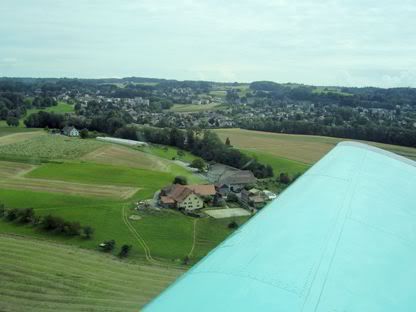
Heading uphill, I nursed the plane into the air with the odd ‘chirrup’ from the stall warner as I was keen to get the gear up to reduce drag (not too close to the ground mind you!). This had the desired effect and I was climbing away nicely.
I switched to Geneva Info who could again hardly conceal their lack of interest! After picking me up on my pronunciation of Yverdon (apparently it should be EEEE – VARE – DONN with an emphasis on ‘DONN’ – are all French speakers a pain in the butt like this?), they asked me to report at the Swiss border.
OK, I am going to have a rant! Why is it that French speakers insist on perfect grammar and pronunciation before they will deign to understand you? I spoke my very poor German in Germany and was usually rewarded with a charming smile and a nod of understanding and with them offering to speak English to put me out of my misery – the French? Oh No!!! Even Dan get a similar response – and French is his native language (OK, OK Quebecois), but really!! To be fair, the French in La Rochelle were an exception.
Up to 4500’ at Yverdon on the shores of Lake Neuchatel and spotted the airfield there. Climbed to 5000’ and spotted the same valley in the Jura that I came through, so let’s use that! Parts of the ridge had some scattered cumulus sitting on them (cumulus granitus!), but the bit I was aiming for was mercifully free of such entertainment. I squeezed through the valley and seven minutes later as the ground was dropping slowly away, crossed the border into France.
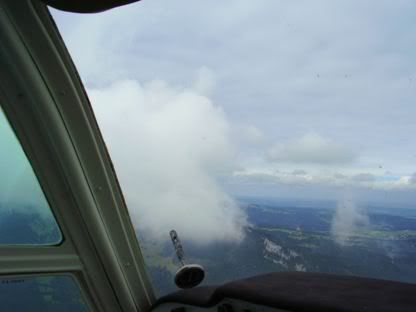
As the land dropped away, so too did the cloudbase. I had to descend to 3500’, then 3000’ then 2500’ bumping my head on the clouds. We chugged along at about 145kts airspeed and 155kts groundspeed according to the GPS and played my favourite airborne version of ‘knock knock, ding-a-ling, cheers’ by seeing who could spot the airfield first – my how the time flies!
I spoke initially to Reims Info on 124.10 then past RLP to Paris Info on 126.10. Both of whom were very helpful.
It was a nice, easy run and we were soon in the Champagne district with loads of fields of vines everywhere and large, imposing chateaus.
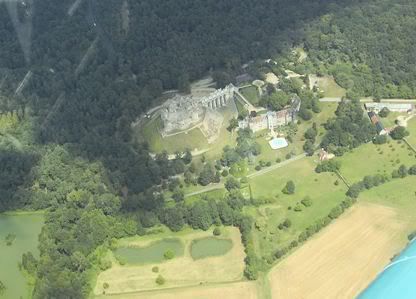
With 25 miles to run, the weather improved and I could see ahead to the coast that it was clear skies – WOO HOOO!. So I contacted Le Touquet – HORROR! The dreaded female controller was on!!
They were busy, I’ll grant you. But she was up to her old tricks of unnecessary and detailed parking instructions and other trivia, clogging up the airwaves so few people could get a word in. Mind you, some of the pilots on frequency need to listen out and pick up their calls first time, that added to the congestion.
Runway 32 was in use and I was approaching on what was a very long final. She helpfully asked me to hold at 10 miles for an extended final approach – fine by me, that’s what I was hoping for. So I took up right hand orbits. I did about three and with Dan starting to look a little green, finally got a call from her asking me where I was (thinks.... where you left me – where do you think!). I replied I was orbiting at 10 miles and she directed to me approach and report at 3 miles. This I did and got a straight to final approach.
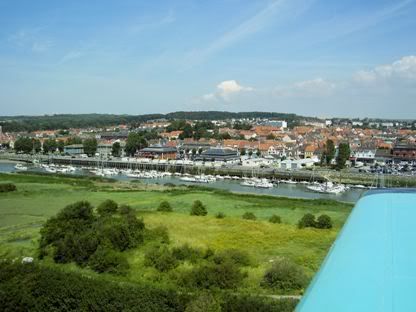
Made a good approach and landing, taxied and parked up. No customs, no hassle as we got a taxi into town for a stroll and a nice pavement lunch at one of the many cafes in town. Bought yet more wine and chocolate (for the wife you understand!) and headed back to the plane about 15:30 local in glorious sunshine.
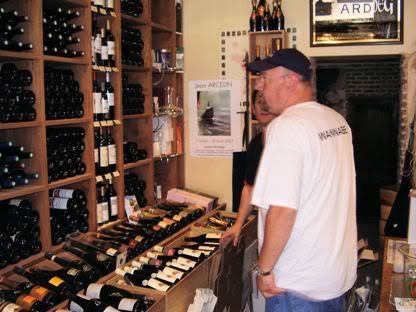
So, small recompense for missing out on Blois and the Loire Valley (note to self – I need to do a serious tour of the various towns and airfields in the Loire Valley). Le Touquet really is a very nice town and well worth a visit in it’s own right and not simply to get the charade of clearing customs over with then dash on to your destination.
So disappointing not to make Blois, but I was worried about getting out of Switzerland. I certainly wasn’t going to chance anything with thunderstorms about. Having said that, without a full IR (I am IMC only), that is what touring in Europe means, go for it, but give yourself flexibility to deal with the weather.
LSGL DCT YVERDON DCT RLP DCT CTL DCT LFAT
We had only planned to stay in Switzerland for two nights, departing early Thursday to go to Blois in the Loire Valley to see Chateau Chambord. The Wednesday in Switzerland was fantastic, warm and sunny with a clear sky and great visibility. When I checked the forecasts on the internet, I got conflicting views. The BBC said clear and sunny the next day, but Swiss Meteo said cloudy with thunderstorms. Our host said that it rarely ‘socked in’ for a day and that if there were storms, they often broke up quick with good weather or at least very large breaks between. So we decided to try for it. We contacted Blois and arranged customs clearance (as this was a prior notification airfield) the previous day.
Thursday dawned tipping down stair-rods with thunder and dramatic fork-lightning. Thinking this might break up, we got a lift to the airfield and waited. And waited and waited and waited.
I wanted a break with higher clouds and a clear view of the Jura ridge we had to cross. I probably saw this once, but with lightning still around and more low cloud about to roll through, there was no way I was even going to start prepping the plane, let alone take off.
I was astonished to see a small plane fly over the airfield not more than 1000’ above with lightning going off all around and I was hardly surprised to see him land 4 minutes later. I guess he was a local Swiss guy, but why he took off in the first place eludes me!

By 12:30, if anything it was worse and rather than lose a whole day, we decided to give it up and hire a car and do our own thing. So that was the last part of the trip cancelled. I only had the plane booked for Friday (not Saturday) and had to have Dan back in the UK by Saturday at the latest for his Sunday flight back home, so re-planning was called for. I legged it out to the aircraft, only to be beaten back once out on the apron by frequent fork lightning all around and me realising what a great target I was all alone on a high airfield on a nice, flat apron!!
I planned a route back to ‘good old’ Le Touquet then on from there to Gloucester. By way of recompense for not staying in France, we thought we would have lunch in Le Touquet if the weather was OK. So I re-planned the route accordingly. Pretty much a straight line following VOR’s to the North West.
Next day, the weather was much better. Not brilliant sunshine, but cloud that was clear of the ridge anyway. I printed the weather off for Europe and the UK from the house on the internet (UK Metoffice site) and went to the airfield again. I paid up, and completed the customs departure form.
To file a flight plan, you have to use one of the two dedicated internet terminals permanently connected to the Austo-Swiss site. The logon and password are pasted onto the terminal and completing the flight plan was simplicity itself – why can’t we have this in the UK??
I checked the plane and emptied most of the water ballast as we were taking yet more goodies and Swiss wine back. I added 1 Qt of oil and carefully checked the fuel tanks for water several times from the fuel drains after the previous days downpour. Not a trace, how wonderful!
Again, Launsanne was operating like an uncontrolled airfield (only this time they mentioned it on the ATIS!). So I started up and taxied out. There was little wind, but take off was to be uphill on 36 (probably the preferred runway for noise abatement reasons). I gave the usual blind calls, did the power checks, checked the circuit and final approach track carefully and lined up on 36.
I started the take-off run and noted the manifold pressure was not as high as normal. I immediately realised that this was due to the pressure altitude, which while not that high, was clearly high and hot enough to affect this. I decided it was not pronounced enough for me to abort the run and try leaning for take-off so elected to continue – making a large mental note to think this carefully through beforehand next time!

Heading uphill, I nursed the plane into the air with the odd ‘chirrup’ from the stall warner as I was keen to get the gear up to reduce drag (not too close to the ground mind you!). This had the desired effect and I was climbing away nicely.
I switched to Geneva Info who could again hardly conceal their lack of interest! After picking me up on my pronunciation of Yverdon (apparently it should be EEEE – VARE – DONN with an emphasis on ‘DONN’ – are all French speakers a pain in the butt like this?), they asked me to report at the Swiss border.
OK, I am going to have a rant! Why is it that French speakers insist on perfect grammar and pronunciation before they will deign to understand you? I spoke my very poor German in Germany and was usually rewarded with a charming smile and a nod of understanding and with them offering to speak English to put me out of my misery – the French? Oh No!!! Even Dan get a similar response – and French is his native language (OK, OK Quebecois), but really!! To be fair, the French in La Rochelle were an exception.
Up to 4500’ at Yverdon on the shores of Lake Neuchatel and spotted the airfield there. Climbed to 5000’ and spotted the same valley in the Jura that I came through, so let’s use that! Parts of the ridge had some scattered cumulus sitting on them (cumulus granitus!), but the bit I was aiming for was mercifully free of such entertainment. I squeezed through the valley and seven minutes later as the ground was dropping slowly away, crossed the border into France.

As the land dropped away, so too did the cloudbase. I had to descend to 3500’, then 3000’ then 2500’ bumping my head on the clouds. We chugged along at about 145kts airspeed and 155kts groundspeed according to the GPS and played my favourite airborne version of ‘knock knock, ding-a-ling, cheers’ by seeing who could spot the airfield first – my how the time flies!
I spoke initially to Reims Info on 124.10 then past RLP to Paris Info on 126.10. Both of whom were very helpful.
It was a nice, easy run and we were soon in the Champagne district with loads of fields of vines everywhere and large, imposing chateaus.

With 25 miles to run, the weather improved and I could see ahead to the coast that it was clear skies – WOO HOOO!. So I contacted Le Touquet – HORROR! The dreaded female controller was on!!
They were busy, I’ll grant you. But she was up to her old tricks of unnecessary and detailed parking instructions and other trivia, clogging up the airwaves so few people could get a word in. Mind you, some of the pilots on frequency need to listen out and pick up their calls first time, that added to the congestion.
Runway 32 was in use and I was approaching on what was a very long final. She helpfully asked me to hold at 10 miles for an extended final approach – fine by me, that’s what I was hoping for. So I took up right hand orbits. I did about three and with Dan starting to look a little green, finally got a call from her asking me where I was (thinks.... where you left me – where do you think!). I replied I was orbiting at 10 miles and she directed to me approach and report at 3 miles. This I did and got a straight to final approach.

Made a good approach and landing, taxied and parked up. No customs, no hassle as we got a taxi into town for a stroll and a nice pavement lunch at one of the many cafes in town. Bought yet more wine and chocolate (for the wife you understand!) and headed back to the plane about 15:30 local in glorious sunshine.

So, small recompense for missing out on Blois and the Loire Valley (note to self – I need to do a serious tour of the various towns and airfields in the Loire Valley). Le Touquet really is a very nice town and well worth a visit in it’s own right and not simply to get the charade of clearing customs over with then dash on to your destination.
So disappointing not to make Blois, but I was worried about getting out of Switzerland. I certainly wasn’t going to chance anything with thunderstorms about. Having said that, without a full IR (I am IMC only), that is what touring in Europe means, go for it, but give yourself flexibility to deal with the weather.
Big Trip 2007 - Koblenz to Lausanne
1.9 hours logged
EDRK DCT KIR DCT GTQ DCT LUL DCT LSGL
While in Koblenz, we got back late one night (actually, make that early one morning!) and of course decided on a beer or three for a nighcap. We got chatting to the guy on the ‘graveyard shift’ at the hotel who served us and it turns out he too is an avid pilot. We talked about the next leg and he had been to Switzerland and Lausanne several times and rates it as his favourite destination. He was extremely helpful and brought in prints of plates and maps showing alternate route into Switzerland the next day that we talked through. Anyway, thank you so much for your help Rainer, it is always good to talk to someone who has actually been to where you want to go and pick up valuable tips – you made it easy for me!
We made our way to the airfield and loaded up.
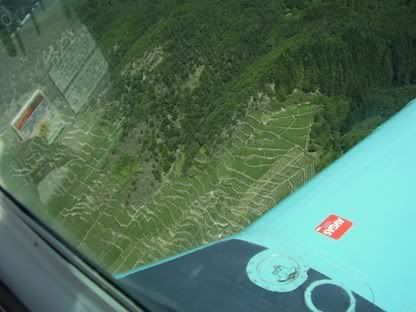
I refuelled and paid up in the tower. I asked about weather (having checked it on the internet at the hotel) and they kindly printed the forecast and en-route TAFs and METARs. The weather for Switzerland was excellent, with clear skies and 40km visibility – just what I was hoping for for this, my first trip into Switzerland and some serious mountains (thinks, hmmmmm – when is a mountain not serious?).
I let out some of the water ballast to compensate for the various pressies we had bought (and no doubt the pounds we had put on in weight).

Just for the hell of it and because it is such a great approach, I asked for a take-off followed by a low approach and go-around, which they agreed to (my guess is that this is not an unusual request!). this I did while Dan snapped away furiously all the way around. I raised the gear and flew over the runway giving the tower a ‘waggle of the wings’ (I thought a victory roll inappropriate in a non-aerobatic plane!).
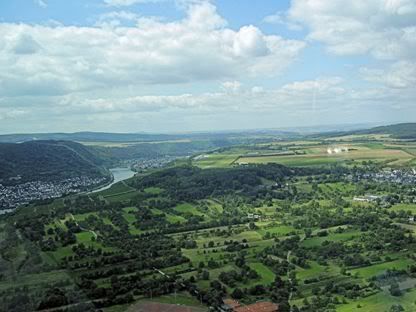
I set track for the KIR VOR, but swung deliberately east a bit to avoid Frankfurt Hahn controlled airspace.
The weather was good with high-ish broken cumulus and I was up to 4000’ easily. I could have gone ‘on-top’ but I was enjoying the view of the ground and was plenty high enough anyway, so why bother? I spoke to Langen Info on 123.52. It was a different controller this time, but again, very professional and helpful.
Approaching the border, I switched to Metz Approach on 125.90 and agreed a zone transit at 4300’. By now, the cumulus had changed to thin scattered cumulus and it was getting thinner and more scattered as I went south as predicted. I recall saying to Dan in Koblenz that just once, it would be nice to fly in a cloudless sky – someone must have been listening as that is what was happening!
I flew on past the GTQ VOR and contacted Reims Info. They immediately suggested I call Luxeuil instead. By the time I cut through their accent and found Luxeuil on the map, I was into their airspace with the airfield in sight – this was one I had missed somehow on the map in my planning! They were gracious about it and granted an immediate (and presumably retrospective) transit rather than scramble the Mirages!
I heard a familiar voice on the airwaves from another aircraft. It was Manuel Quieroz in his RV6, G-GDRV. I asked for and got an ‘air-to-air’ and said a quick hello. Manuel must have had trouble hearing the lady controller who asked several times for his full registration, so I relayed, deciding to help out this clearly inexperienced pilot – you really should get some hours in flying abroad Manuel (Manuel of course recently flew around the world in the RV6 in ‘Chasing the Morning Sun’!!!).
I went back to Reims Info as the ground got closer to the plane despite me flying at 4700’. It was getting more rugged as we approached the Jura Mountains. Reims got rid of me with 50nm to run to Lausanne and while still well inside France (cheers pal!). So I called Geneva Info on 126.35 who promptly suggested I contact Reins Info! I stayed on listening watch and Geneva Info couldn’t care less until you enter Swiss airspace (seems reasonable I guess).
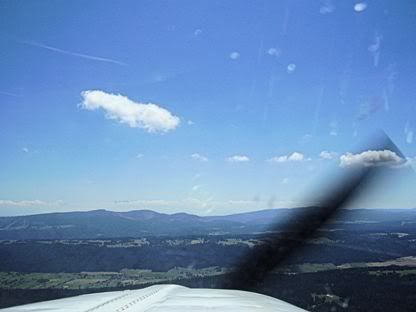
I was aiming for a ‘notch’ in the Jura Mountains ahead of me now. As usual, from this distance, it looked like I needed more altitude. I decided to climb to 5000’ and see where we went from there, as I would only have to lose it again fairly quickly to get into Lausanne, only about 25 miles inside the border (I didn’t want a repeat performance of getting into Cannes last year where I was at 8000’ when the mountains fell away to reveal Cannes airfield at sea level with 30 miles to run!). Closer still, I decided on 5500’ for the crossing. We saw Mont Blanc sticking up clearly through the inversion layer on the horizon.
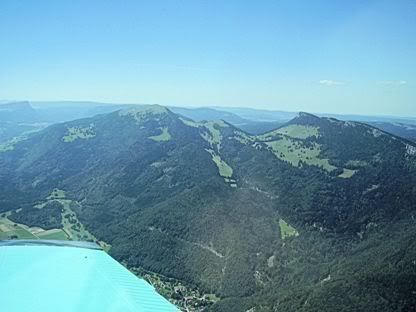
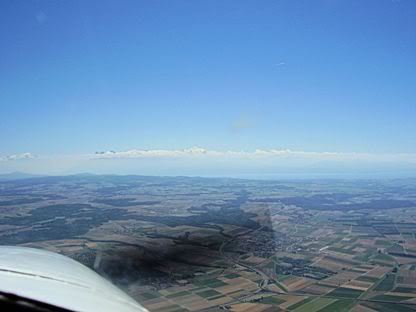
The ‘notch’ in the ridge turned out to be a small ‘pass’, so I used that and crossed the Jura Mountains with mountains above me on either side. By now, I was talking to a somewhat dis-interested Geneva Info who advise me to report at Yverdon on Lake Neuchatel.
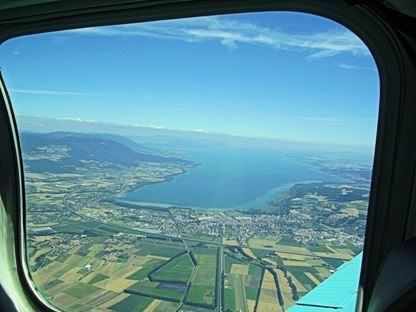
I passed Yverdon and changed to Lausanne ATIS, picked up the ATIS and called the tower frequency. I heard a lot of calls, but no reply from the tower.
Descended to 3700’ as per the approach plates and approached for a left downwind join for runway 36 in use. I was still giving blind calls. While about 2 miles from downwind, I had a ‘close encounter of the brown trouser kind’ with a lovely yellow Piper Cub – only it wasn’t so lovely at the time. A classic case of ‘high wing below / low wing above’. I am sure neither saw the other until he had passed underneath!
I carried on giving blind calls and realised that everyone else was doing the same, so despite the ‘Tower’ designation, it appeared to be operating as an uncontrolled airfield – not a problem, just not what I was expecting – and boy, was it busy! The weather could not have been better, with clear blue skies and unlimited visibility.
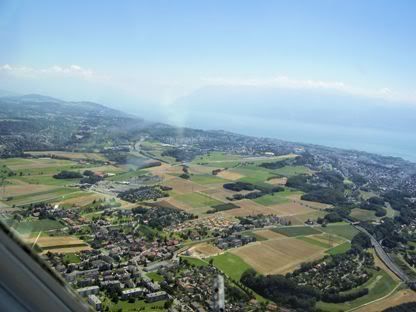
This was another interesting airfield. At 1800’ it is the highest I have been to. It is on the northern edge of the town or Lausanne on the shores of Lake Geneva. The runway is not overly generous at about 850m and has an interesting 2.5 degree upslope on runway 36 – so I was glad I wasn’t landing on 18!
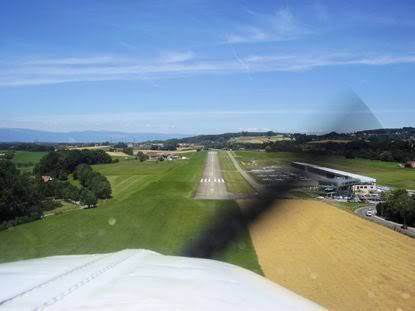
The approach is again very scenic, over the town while Dan was snapping away. I was ready for the optical illusion of an up-sloping runway and I mad e the final approach and gave my last blind call. This was rewarded by a good landing. As we wanted to get away early in two days time, I taxied straight to the pumps. Of course we had to get the keys from the tower, so Dan went off at a trot to collect the keys. He returned and we completed the refuelling easily enough and parked up on the carefully marked areas.
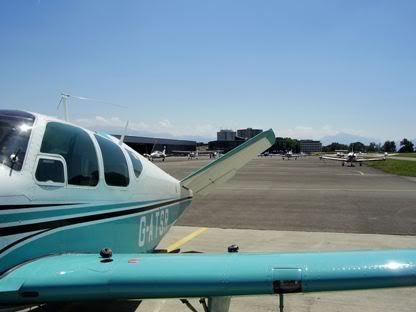
I checked into the reporting point in a smart, new terminal building where we filled out a customs arrival form. The lady told Dan (in French) that we had to wait for 30 minutes and if the customs officers didn’t show, we were free to go. There was a nice restaurant / bar downstairs, so it wasn’t a hardship. However, 10 minutes later, the lady appeared and explained that I might not have parked carefully enough. So she took me back to the plane in a car and inspected where the wheels were in relation to the ramp markings. Sure enough, I had missed the yellow line by about one foot, but she shrugged and said that was close enough – in broken English she explained that it was hard to see exactly from the tower and that space on the ramp was very tight.
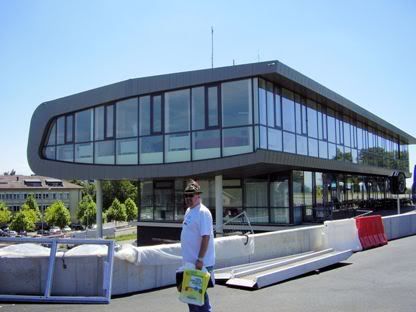
We were met by our mutual erstwhile next-door neighbour who now works for the Olympic federation in Lausanne. We had arranged to stay with him and his family nearby and by coincidence, the next day was also Swiss National day with fireworks all over Lake Geneva.
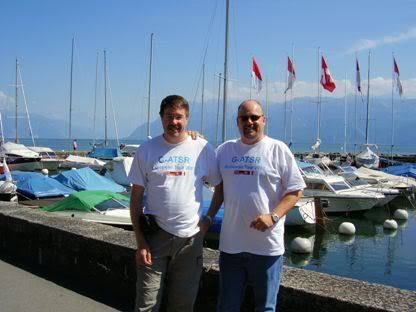
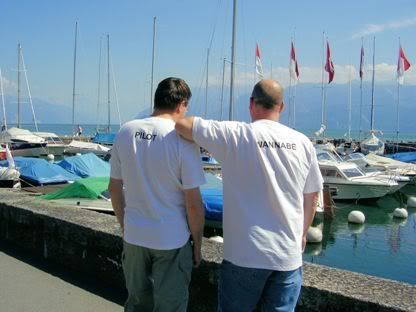
The landing fee was SFr 32.00, Passenger Tax was SFr 6.10, Parking for 3 days was SFr 38.70 and there were minor charged for customs. All at a rate of around GBP 1.00 to SFr 2.35. Fuel was a bit cheaper but not hugely so.
My first trip in a small plane to Switzerland and my first bit of ‘serious’ mountain flying (no – I don’t count the Lake District or the welsh Hills), although I could hardly have chosen better weather for it, so not a huge challenge. But what a beautiful country and what fun it would be to land at other Swiss airfield – maybe next time!
EDRK DCT KIR DCT GTQ DCT LUL DCT LSGL
While in Koblenz, we got back late one night (actually, make that early one morning!) and of course decided on a beer or three for a nighcap. We got chatting to the guy on the ‘graveyard shift’ at the hotel who served us and it turns out he too is an avid pilot. We talked about the next leg and he had been to Switzerland and Lausanne several times and rates it as his favourite destination. He was extremely helpful and brought in prints of plates and maps showing alternate route into Switzerland the next day that we talked through. Anyway, thank you so much for your help Rainer, it is always good to talk to someone who has actually been to where you want to go and pick up valuable tips – you made it easy for me!
We made our way to the airfield and loaded up.

I refuelled and paid up in the tower. I asked about weather (having checked it on the internet at the hotel) and they kindly printed the forecast and en-route TAFs and METARs. The weather for Switzerland was excellent, with clear skies and 40km visibility – just what I was hoping for for this, my first trip into Switzerland and some serious mountains (thinks, hmmmmm – when is a mountain not serious?).
I let out some of the water ballast to compensate for the various pressies we had bought (and no doubt the pounds we had put on in weight).

Just for the hell of it and because it is such a great approach, I asked for a take-off followed by a low approach and go-around, which they agreed to (my guess is that this is not an unusual request!). this I did while Dan snapped away furiously all the way around. I raised the gear and flew over the runway giving the tower a ‘waggle of the wings’ (I thought a victory roll inappropriate in a non-aerobatic plane!).

I set track for the KIR VOR, but swung deliberately east a bit to avoid Frankfurt Hahn controlled airspace.
The weather was good with high-ish broken cumulus and I was up to 4000’ easily. I could have gone ‘on-top’ but I was enjoying the view of the ground and was plenty high enough anyway, so why bother? I spoke to Langen Info on 123.52. It was a different controller this time, but again, very professional and helpful.
Approaching the border, I switched to Metz Approach on 125.90 and agreed a zone transit at 4300’. By now, the cumulus had changed to thin scattered cumulus and it was getting thinner and more scattered as I went south as predicted. I recall saying to Dan in Koblenz that just once, it would be nice to fly in a cloudless sky – someone must have been listening as that is what was happening!
I flew on past the GTQ VOR and contacted Reims Info. They immediately suggested I call Luxeuil instead. By the time I cut through their accent and found Luxeuil on the map, I was into their airspace with the airfield in sight – this was one I had missed somehow on the map in my planning! They were gracious about it and granted an immediate (and presumably retrospective) transit rather than scramble the Mirages!
I heard a familiar voice on the airwaves from another aircraft. It was Manuel Quieroz in his RV6, G-GDRV. I asked for and got an ‘air-to-air’ and said a quick hello. Manuel must have had trouble hearing the lady controller who asked several times for his full registration, so I relayed, deciding to help out this clearly inexperienced pilot – you really should get some hours in flying abroad Manuel (Manuel of course recently flew around the world in the RV6 in ‘Chasing the Morning Sun’!!!).
I went back to Reims Info as the ground got closer to the plane despite me flying at 4700’. It was getting more rugged as we approached the Jura Mountains. Reims got rid of me with 50nm to run to Lausanne and while still well inside France (cheers pal!). So I called Geneva Info on 126.35 who promptly suggested I contact Reins Info! I stayed on listening watch and Geneva Info couldn’t care less until you enter Swiss airspace (seems reasonable I guess).

I was aiming for a ‘notch’ in the Jura Mountains ahead of me now. As usual, from this distance, it looked like I needed more altitude. I decided to climb to 5000’ and see where we went from there, as I would only have to lose it again fairly quickly to get into Lausanne, only about 25 miles inside the border (I didn’t want a repeat performance of getting into Cannes last year where I was at 8000’ when the mountains fell away to reveal Cannes airfield at sea level with 30 miles to run!). Closer still, I decided on 5500’ for the crossing. We saw Mont Blanc sticking up clearly through the inversion layer on the horizon.


The ‘notch’ in the ridge turned out to be a small ‘pass’, so I used that and crossed the Jura Mountains with mountains above me on either side. By now, I was talking to a somewhat dis-interested Geneva Info who advise me to report at Yverdon on Lake Neuchatel.

I passed Yverdon and changed to Lausanne ATIS, picked up the ATIS and called the tower frequency. I heard a lot of calls, but no reply from the tower.
Descended to 3700’ as per the approach plates and approached for a left downwind join for runway 36 in use. I was still giving blind calls. While about 2 miles from downwind, I had a ‘close encounter of the brown trouser kind’ with a lovely yellow Piper Cub – only it wasn’t so lovely at the time. A classic case of ‘high wing below / low wing above’. I am sure neither saw the other until he had passed underneath!
I carried on giving blind calls and realised that everyone else was doing the same, so despite the ‘Tower’ designation, it appeared to be operating as an uncontrolled airfield – not a problem, just not what I was expecting – and boy, was it busy! The weather could not have been better, with clear blue skies and unlimited visibility.

This was another interesting airfield. At 1800’ it is the highest I have been to. It is on the northern edge of the town or Lausanne on the shores of Lake Geneva. The runway is not overly generous at about 850m and has an interesting 2.5 degree upslope on runway 36 – so I was glad I wasn’t landing on 18!

The approach is again very scenic, over the town while Dan was snapping away. I was ready for the optical illusion of an up-sloping runway and I mad e the final approach and gave my last blind call. This was rewarded by a good landing. As we wanted to get away early in two days time, I taxied straight to the pumps. Of course we had to get the keys from the tower, so Dan went off at a trot to collect the keys. He returned and we completed the refuelling easily enough and parked up on the carefully marked areas.

I checked into the reporting point in a smart, new terminal building where we filled out a customs arrival form. The lady told Dan (in French) that we had to wait for 30 minutes and if the customs officers didn’t show, we were free to go. There was a nice restaurant / bar downstairs, so it wasn’t a hardship. However, 10 minutes later, the lady appeared and explained that I might not have parked carefully enough. So she took me back to the plane in a car and inspected where the wheels were in relation to the ramp markings. Sure enough, I had missed the yellow line by about one foot, but she shrugged and said that was close enough – in broken English she explained that it was hard to see exactly from the tower and that space on the ramp was very tight.

We were met by our mutual erstwhile next-door neighbour who now works for the Olympic federation in Lausanne. We had arranged to stay with him and his family nearby and by coincidence, the next day was also Swiss National day with fireworks all over Lake Geneva.


The landing fee was SFr 32.00, Passenger Tax was SFr 6.10, Parking for 3 days was SFr 38.70 and there were minor charged for customs. All at a rate of around GBP 1.00 to SFr 2.35. Fuel was a bit cheaper but not hugely so.
My first trip in a small plane to Switzerland and my first bit of ‘serious’ mountain flying (no – I don’t count the Lake District or the welsh Hills), although I could hardly have chosen better weather for it, so not a huge challenge. But what a beautiful country and what fun it would be to land at other Swiss airfield – maybe next time!
Saturday, August 04, 2007
Big Trip 2007 - Gloucester to Koblenz
2.7 hours logged
EGBJ DCT BNN DCT LAM DCT DVR DCT MK DCT HUL DCT SPI DCT EDRK
So, this was the start of the ‘big trip’ for 2007. My buddy, Dan had arrived from Canada the previous week and seen a number of friends around the local area of Gloucester (yes, during the floods)! So we were both a bit relieved to be leaving the Gloucester area on a flying holiday – at least we could have more than a facecloth wash every night!
We rocked up at Gloucester airport on Saturday 29th July at about 10:30. I filed the flight plan with the reception desk (having filed the GAR the previous day). We unloaded and Dan carried the two 15l collapsible plastic camping containers full of precious water to act as ballast in the baggage compartment to counter-balance us two hefty guys in the front and keep us within the balance graph.
We loaded up and I taxied out to the pumps. As I was filling up, a rather nice looking Piper Meridien pulled up behind us and it was a fellow ‘Flyer Forumite’ Steven in his flashy mini-airliner – very nice too! We filled up and pulled forward so Steven could pull in behind and fill up while we faffed around.
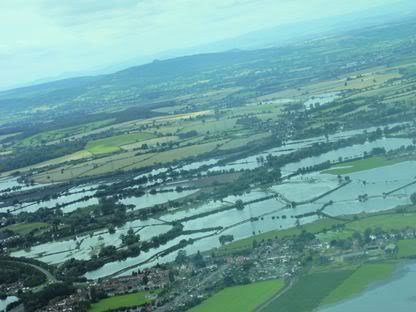
We were soon airborne. Dan was busy taking pictures of all the flooding in the local area, while I did a left turnout from runway 27 to set course direct to the BNN VOR and through Brize airspace.
I requested and got transit through Brize with a controller who was very interested that we were heading for Koblenz. He said he was posted there for a few years and were we going for the ‘Rhine on fire’ festival? I confess I had never heard of this and said no. He said it was on about now, so we may have struck it lucky.
I levelled out at 2700’ – no point in going any higher as we would only have to descend again to below 2500’ to stay under the London TMA. My attention wandered and I climbed a further 200’. Just as I was about to correct, a PA28 passed diagonally underneath us about 200’ below! No, probably neither of us saw each other.
We watched carefully to the north east for the NOTAM’d glider competition at Bicester. We spotted on which was no conflict. Clear of Brize zone, I changed to London Information on 126.40. They were very quiet indeed for a Saturday. Got FIS and ran the low level ‘corridor’ to the north of London under the TMA at 2400’. I stayed with London Info for the short channel crossing from Dover to Calais, but climbed to 4000’ for the crossing. The weather was good with few clouds and good visibility over the channel.
At the FIR, I changed to Lille Info on 120.27 and stayed with them until near the Belgian border. Around the coast at Calais, I had to descend to 2200’ to remain VMC, but as is common, once further inland, this lifted and I was able to climb to 3000’.
Changed to Brussels Info on 126.90. I heard him, but he said I was unreadable, so I should remain clear of controlled airspace. I wasn’t due to go near any for a while yet, so stayed on listening watch for now. I tried again later and was reported as strength 3, but still no FIS. I finally got through to him near the town of Kortrijk at 3700’ with category C airspace 15 nm ahead starting at 3500’. I asked for transit and he replied ‘you remain clear of controlled airspace unless you have approval for transit’ in his best petulant ‘I am a controller - what does this idiot think he is doing’ tone of voice!
I said that I knew that and that is why I was requesting transit! He responded with a terse ‘you call Brussels Approach on XXX.XX’. I don’t often come across unhelpful ground stations, but this guy was a real pl*nker! I was not sorry to switch.
In contrast, Brussels Approach were relaxed and very helpful. I got transit approval at 3900’ and was also advised that Beauvechain was closed, so no transit was required for them.
Once clear of their airspace, I switched to Liege Approach on 119.27 and got immediate transit approval through their airspace to the south on a direct track from HUL to SPI VOR’s.
The landscape changed from carefully tended fields to large forested areas – so we were in the Belgian Ardennes – scene of the famous ‘Battle of the Bulge’ from WW2. I knew this was rugged terrain from the road-trip we took last year. I spotted the Spa airfield easily and decided to follow the road to the infamous town of Malmedy.
I changed to Langen Info on 123.52 and crossed into German airspace for the first time. They were great and warned me about an active danger area and gave me vectors to avoid – ooops! That’ll teach me to take unscheduled detours!
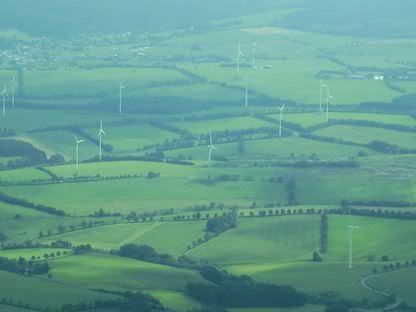
Then, it was a straight and easy run into Koblenz. It took a while for either of us to spot the airfield as we were approaching it from ‘the back’. I got it at 5 miles.
Joined downwind for runway 24 with right hand circuits. I was a bit close in. I turned base and saw the amazing sight of Koblenz in the valley that dropped sharply away from the airfield – so this is the ‘aircraft carrier’ airfield I had read so much about – a good analogy, except of course, there was plenty of tarmac!
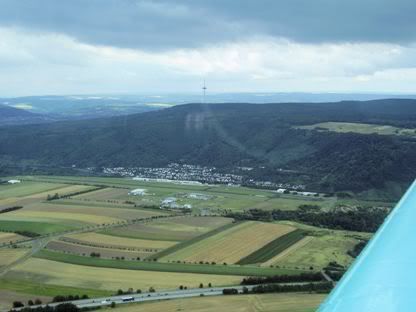
I was so carried away by the view and misjudged the strong crosswind, that by the time I checked again, I had badly over-cooked the base leg and cranked the plane around hard to regain a sensible final approach track. I really should have gone around, but thought it might be fun to rescue it instead. The crosswind was something, it must have been a full 20 kts – given that, it was a reasonable crosswind landing.
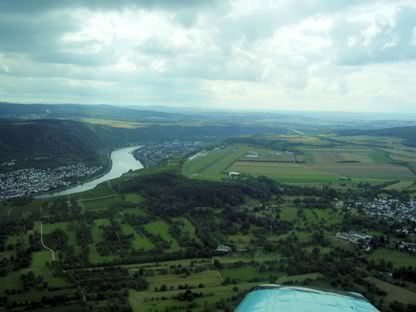
I taxied in and parked up on the grass. We unloaded, locked up and put the cover on the plane. Dan and I then walked past some onlookers outside the tower who stared in disbelief at our ‘team t-shirts’ complete with Bavarian green hunting hats festooned with badges (yes, we really did wear these during the trip and out on the streets – more of this later). Have these people no sense of style or taste?
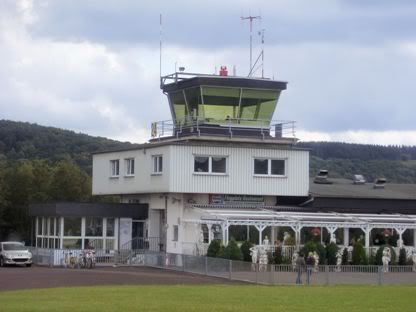
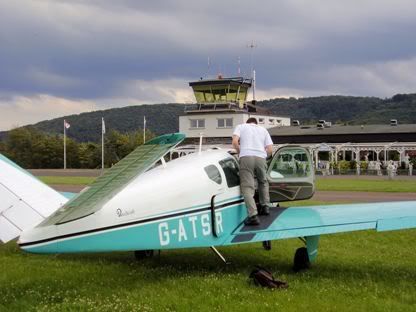
I went up to report to the tower and the guy up there was fantastic and very helpful indeed and suggested I pay on departure. He closed the flight plan and called a taxi.
As this is a flying blog and not a travelog, I won’t say much about Koblenz, except that we stayed in the Accor Ibis in the centre of Koblenz. The Accor hotels are a pilots dream as you can book on-line and cancel the same day either on-line or by phone, making them ideal for pilots who get weathered in (as I was to find out later).
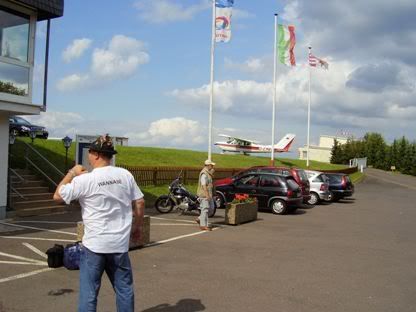
Koblenz itself was great and it is a bustling, working town. The ‘Rhine on fire’ wasn’t for two weeks yet, so we would miss that. We saw pretty much all the sights you could see on foot and enjoyed the fine food and especially the local wine and beer!
So, my first trip in a small plane to Germany and it was pretty easy. Belgian airspace can look intimidating, but once past the tw*t on Brussels Info, transits were easy to get. German airspace was very easy and Langen Info very professional and helpful.
Koblenz is a very scenic airfield and has a spectacular approach that make it very well worth visiting – just watch out for that crosswind!
The costs at Koblenz? Landing fee EUR 24.00, 3 days parking EUR 17.55 – while not ‘dirt cheap’ French prices, certainly pretty reasonable. Fuel was a bit more expensive than in the UK though.
EGBJ DCT BNN DCT LAM DCT DVR DCT MK DCT HUL DCT SPI DCT EDRK
So, this was the start of the ‘big trip’ for 2007. My buddy, Dan had arrived from Canada the previous week and seen a number of friends around the local area of Gloucester (yes, during the floods)! So we were both a bit relieved to be leaving the Gloucester area on a flying holiday – at least we could have more than a facecloth wash every night!
We rocked up at Gloucester airport on Saturday 29th July at about 10:30. I filed the flight plan with the reception desk (having filed the GAR the previous day). We unloaded and Dan carried the two 15l collapsible plastic camping containers full of precious water to act as ballast in the baggage compartment to counter-balance us two hefty guys in the front and keep us within the balance graph.
We loaded up and I taxied out to the pumps. As I was filling up, a rather nice looking Piper Meridien pulled up behind us and it was a fellow ‘Flyer Forumite’ Steven in his flashy mini-airliner – very nice too! We filled up and pulled forward so Steven could pull in behind and fill up while we faffed around.

We were soon airborne. Dan was busy taking pictures of all the flooding in the local area, while I did a left turnout from runway 27 to set course direct to the BNN VOR and through Brize airspace.
I requested and got transit through Brize with a controller who was very interested that we were heading for Koblenz. He said he was posted there for a few years and were we going for the ‘Rhine on fire’ festival? I confess I had never heard of this and said no. He said it was on about now, so we may have struck it lucky.
I levelled out at 2700’ – no point in going any higher as we would only have to descend again to below 2500’ to stay under the London TMA. My attention wandered and I climbed a further 200’. Just as I was about to correct, a PA28 passed diagonally underneath us about 200’ below! No, probably neither of us saw each other.
We watched carefully to the north east for the NOTAM’d glider competition at Bicester. We spotted on which was no conflict. Clear of Brize zone, I changed to London Information on 126.40. They were very quiet indeed for a Saturday. Got FIS and ran the low level ‘corridor’ to the north of London under the TMA at 2400’. I stayed with London Info for the short channel crossing from Dover to Calais, but climbed to 4000’ for the crossing. The weather was good with few clouds and good visibility over the channel.
At the FIR, I changed to Lille Info on 120.27 and stayed with them until near the Belgian border. Around the coast at Calais, I had to descend to 2200’ to remain VMC, but as is common, once further inland, this lifted and I was able to climb to 3000’.
Changed to Brussels Info on 126.90. I heard him, but he said I was unreadable, so I should remain clear of controlled airspace. I wasn’t due to go near any for a while yet, so stayed on listening watch for now. I tried again later and was reported as strength 3, but still no FIS. I finally got through to him near the town of Kortrijk at 3700’ with category C airspace 15 nm ahead starting at 3500’. I asked for transit and he replied ‘you remain clear of controlled airspace unless you have approval for transit’ in his best petulant ‘I am a controller - what does this idiot think he is doing’ tone of voice!
I said that I knew that and that is why I was requesting transit! He responded with a terse ‘you call Brussels Approach on XXX.XX’. I don’t often come across unhelpful ground stations, but this guy was a real pl*nker! I was not sorry to switch.
In contrast, Brussels Approach were relaxed and very helpful. I got transit approval at 3900’ and was also advised that Beauvechain was closed, so no transit was required for them.
Once clear of their airspace, I switched to Liege Approach on 119.27 and got immediate transit approval through their airspace to the south on a direct track from HUL to SPI VOR’s.
The landscape changed from carefully tended fields to large forested areas – so we were in the Belgian Ardennes – scene of the famous ‘Battle of the Bulge’ from WW2. I knew this was rugged terrain from the road-trip we took last year. I spotted the Spa airfield easily and decided to follow the road to the infamous town of Malmedy.
I changed to Langen Info on 123.52 and crossed into German airspace for the first time. They were great and warned me about an active danger area and gave me vectors to avoid – ooops! That’ll teach me to take unscheduled detours!

Then, it was a straight and easy run into Koblenz. It took a while for either of us to spot the airfield as we were approaching it from ‘the back’. I got it at 5 miles.
Joined downwind for runway 24 with right hand circuits. I was a bit close in. I turned base and saw the amazing sight of Koblenz in the valley that dropped sharply away from the airfield – so this is the ‘aircraft carrier’ airfield I had read so much about – a good analogy, except of course, there was plenty of tarmac!

I was so carried away by the view and misjudged the strong crosswind, that by the time I checked again, I had badly over-cooked the base leg and cranked the plane around hard to regain a sensible final approach track. I really should have gone around, but thought it might be fun to rescue it instead. The crosswind was something, it must have been a full 20 kts – given that, it was a reasonable crosswind landing.

I taxied in and parked up on the grass. We unloaded, locked up and put the cover on the plane. Dan and I then walked past some onlookers outside the tower who stared in disbelief at our ‘team t-shirts’ complete with Bavarian green hunting hats festooned with badges (yes, we really did wear these during the trip and out on the streets – more of this later). Have these people no sense of style or taste?


I went up to report to the tower and the guy up there was fantastic and very helpful indeed and suggested I pay on departure. He closed the flight plan and called a taxi.
As this is a flying blog and not a travelog, I won’t say much about Koblenz, except that we stayed in the Accor Ibis in the centre of Koblenz. The Accor hotels are a pilots dream as you can book on-line and cancel the same day either on-line or by phone, making them ideal for pilots who get weathered in (as I was to find out later).

Koblenz itself was great and it is a bustling, working town. The ‘Rhine on fire’ wasn’t for two weeks yet, so we would miss that. We saw pretty much all the sights you could see on foot and enjoyed the fine food and especially the local wine and beer!
So, my first trip in a small plane to Germany and it was pretty easy. Belgian airspace can look intimidating, but once past the tw*t on Brussels Info, transits were easy to get. German airspace was very easy and Langen Info very professional and helpful.
Koblenz is a very scenic airfield and has a spectacular approach that make it very well worth visiting – just watch out for that crosswind!
The costs at Koblenz? Landing fee EUR 24.00, 3 days parking EUR 17.55 – while not ‘dirt cheap’ French prices, certainly pretty reasonable. Fuel was a bit more expensive than in the UK though.
Subscribe to:
Posts (Atom)
